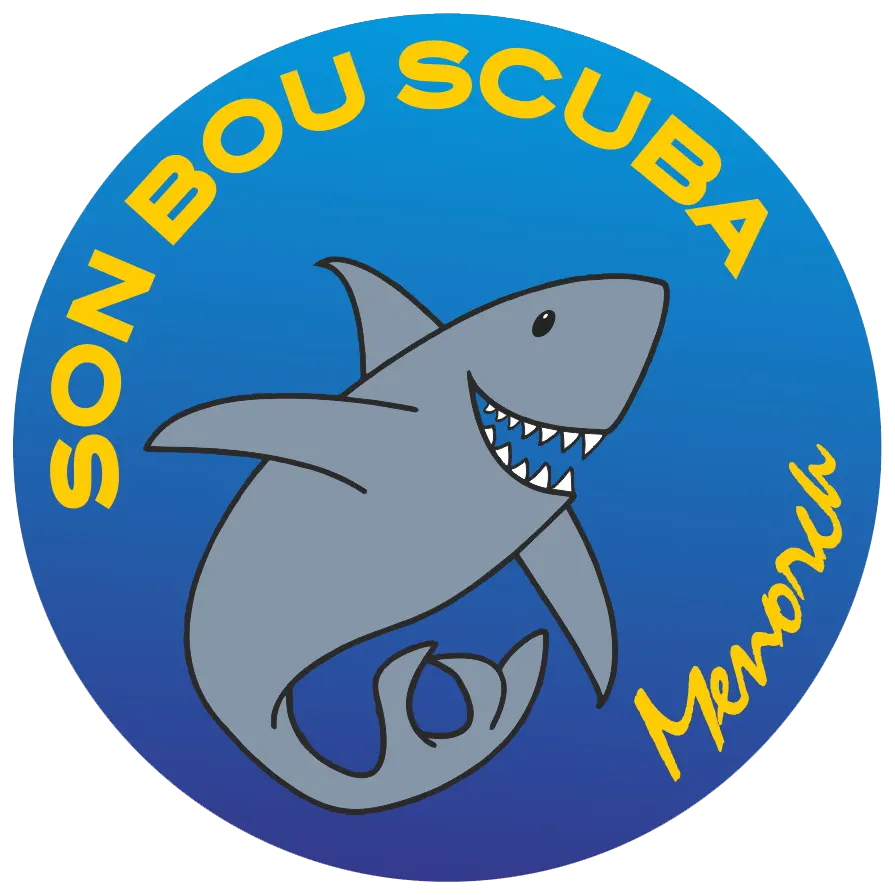Dive sites Menorca: So much to explore!
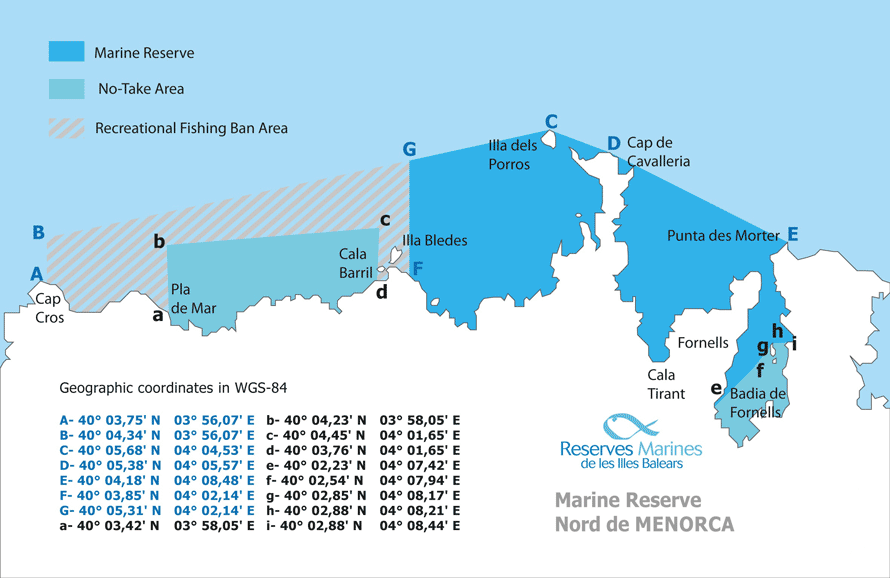
Our dive sites
Diving at Son Bou Scuba is more than being underwater. We enjoy our work, which is why we only dive the best dive sites Menorca has to offer!
Depending on your experience, we have around 45 dive sites available, divided all over the island. Caves & caverns, drop-offs, wrecks and reefs offer unexpected colours and marine life. And all that with visibility averaging over 30 meters and water temperatures of 28 degrees in the summer months.
Northern Marine Reserve
We are one of the few dive centres licensed to dive the Northern Marine Reserve. Here you will find a wealth of fish, such as large groupers, tuna and banks of barracuda’s.
Cave and cavern diving on Menorca
Menorca has an impressive underwater landscape with many caves and caverns, some of the most beautiful in the Mediterranean. Therefore, we have a selection of the 15 most beautiful caves and caverns for you in our programme, such as the famous Pont d’en Gil cavern, Swiss Cheese, La Catedral and the Belltower.
Most caverns are also accessible to divers with less experience, as the exit is always visible. In some of them, we can surface to admire the stalactites and stalagmites.
Below is a selection of our dive sites. The stars are an indication of the difficulty level (1-4):

Belltower **
Many of our divers consider this to be the best cavern dive in the Cap d'en Font area. We can access this cavern through two different entrances, after which we find ourselves in a large tunnel which goes about 70 metres into the rocky coastline. At the end of the tunnel is a large air bubble, where we can emerge and admire the stalactites above us
Depth 14 - 22 metres.

Cala Viola * (marine reserve)
This dive starts from a small beach that gradually drops downs to a depth of 6 metres and is usually full of small fish, barracudas and a few stingrays. Following the reef to the left, we can see a large aluminium mast in the sea grass. Following the mast we find the remains of the 22-metre French sailing yacht 'Chrisaldy' at a depth between 14 - 18 metres. In February 1996 it was washed onto the rocks here and broken in several pieces. The remains of this wreck are spread over a large area and offer interesting settings for underwater photographers.
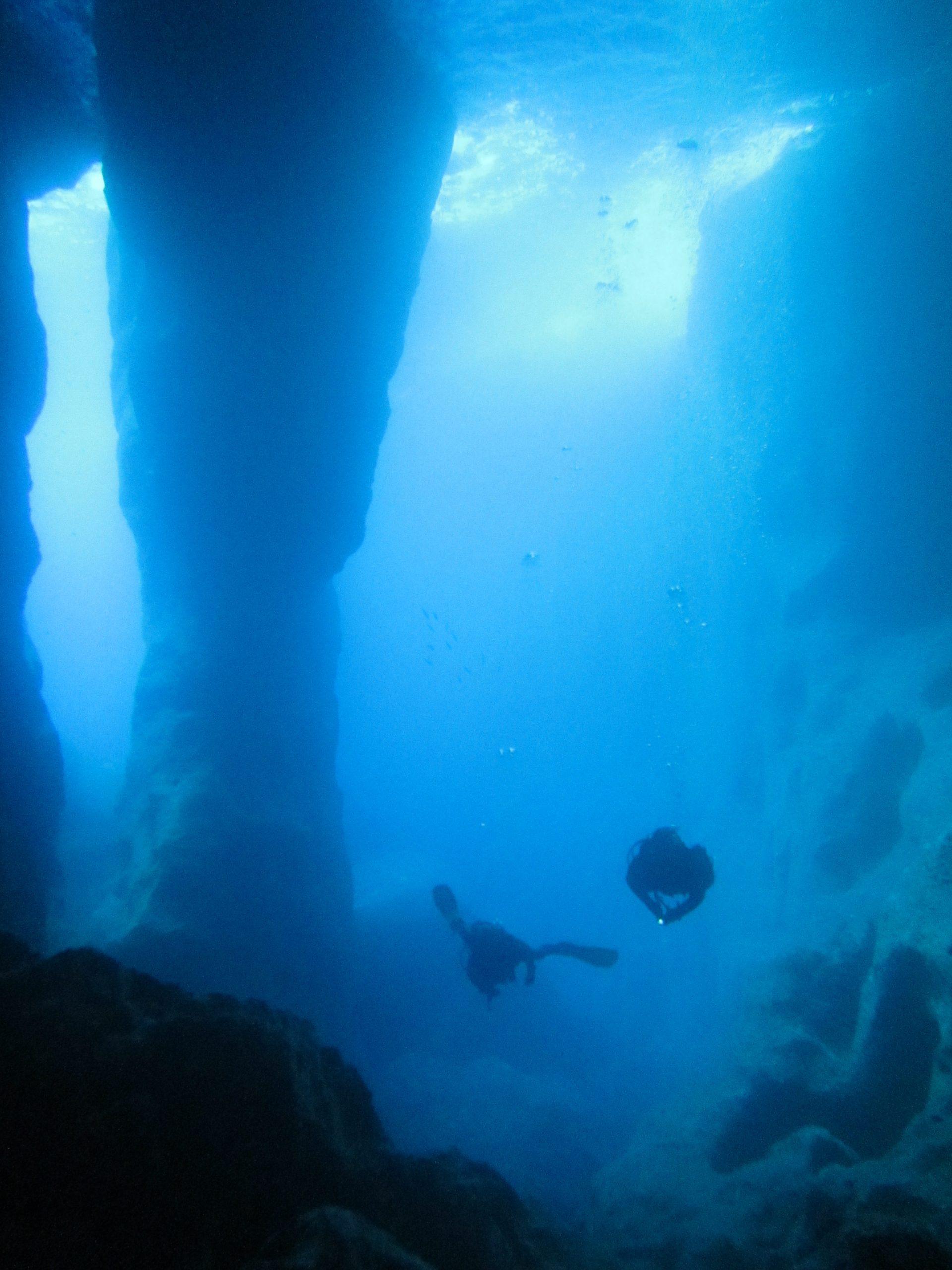
Cueva de los Ingleses **
Cueva de los Ingleses is located just outside the Northern Marine Reserve, and can be reached after a short boat ride. We anchor close to the entrance of the cavern and start the dive swimming away from the coast, until reaching a depth of 25 metres. With a bit of luck we can see some groupers and lobsters. Before running out of bottom time we ascend towards the entrance of the cavern at 14 metres. The opening of the cavern continues on the surface, so it is possible to surface within, with a view to the north. We will explore from right to left following the contours of the cavern and look for shrimps, lobsters, crabs and other crustaceans typical of these environments. Looking back towards the entrance we can enjoy the beautiful backlight with an spectacular column on the left.
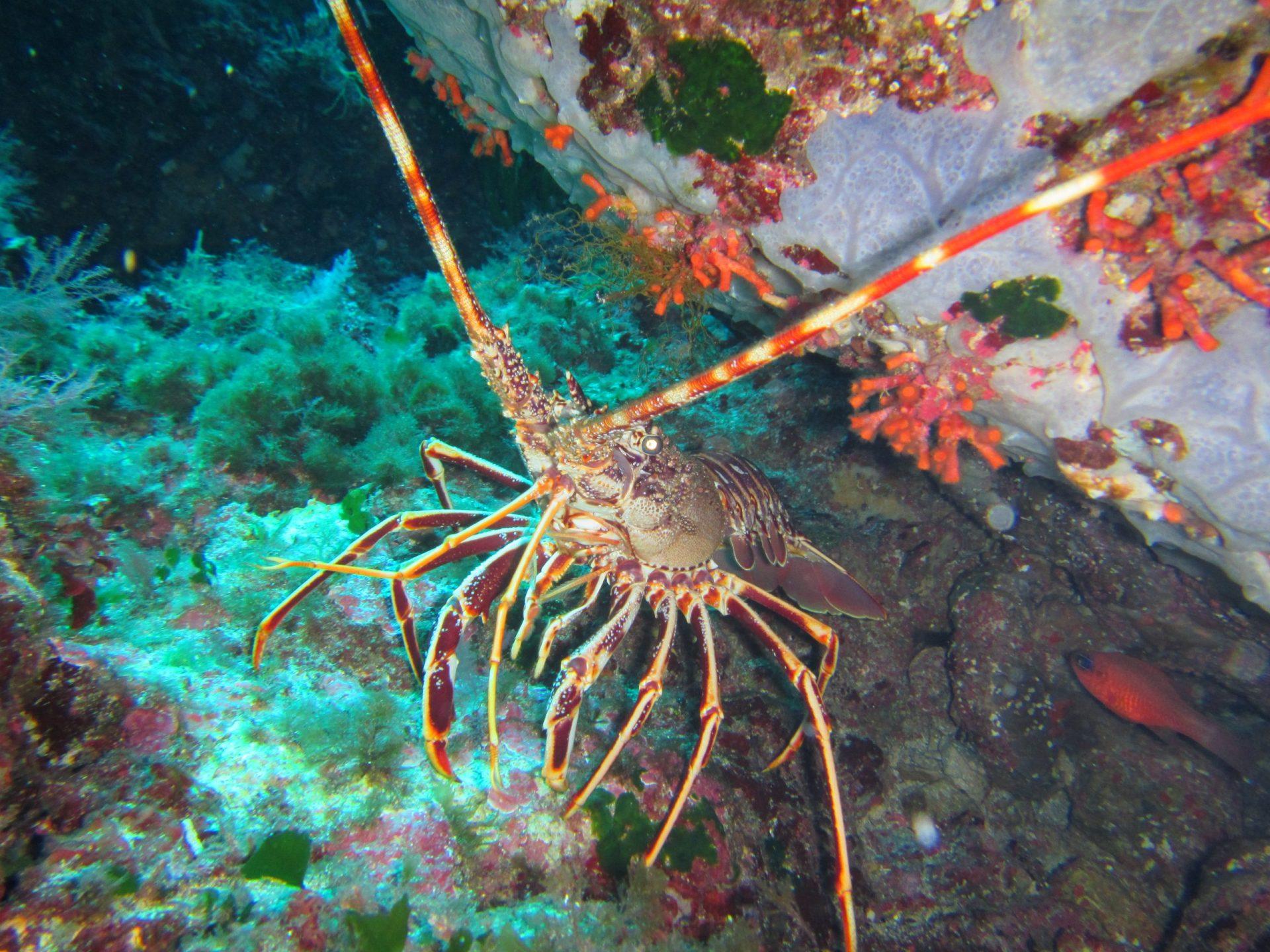
East End */**
This dive site is one of our favourite locations! Here we can find all the ingredients for a fantastic dive; depths up to 30 metres, a superb landscape with huge boulders and lots of marine life such as stingrays, flying gurnards, moray eels, spiny lobsters, nudibranchs, octopuses and piper gurnards. A dive for all levels, as the depth can easily be adapted to one’s experience.
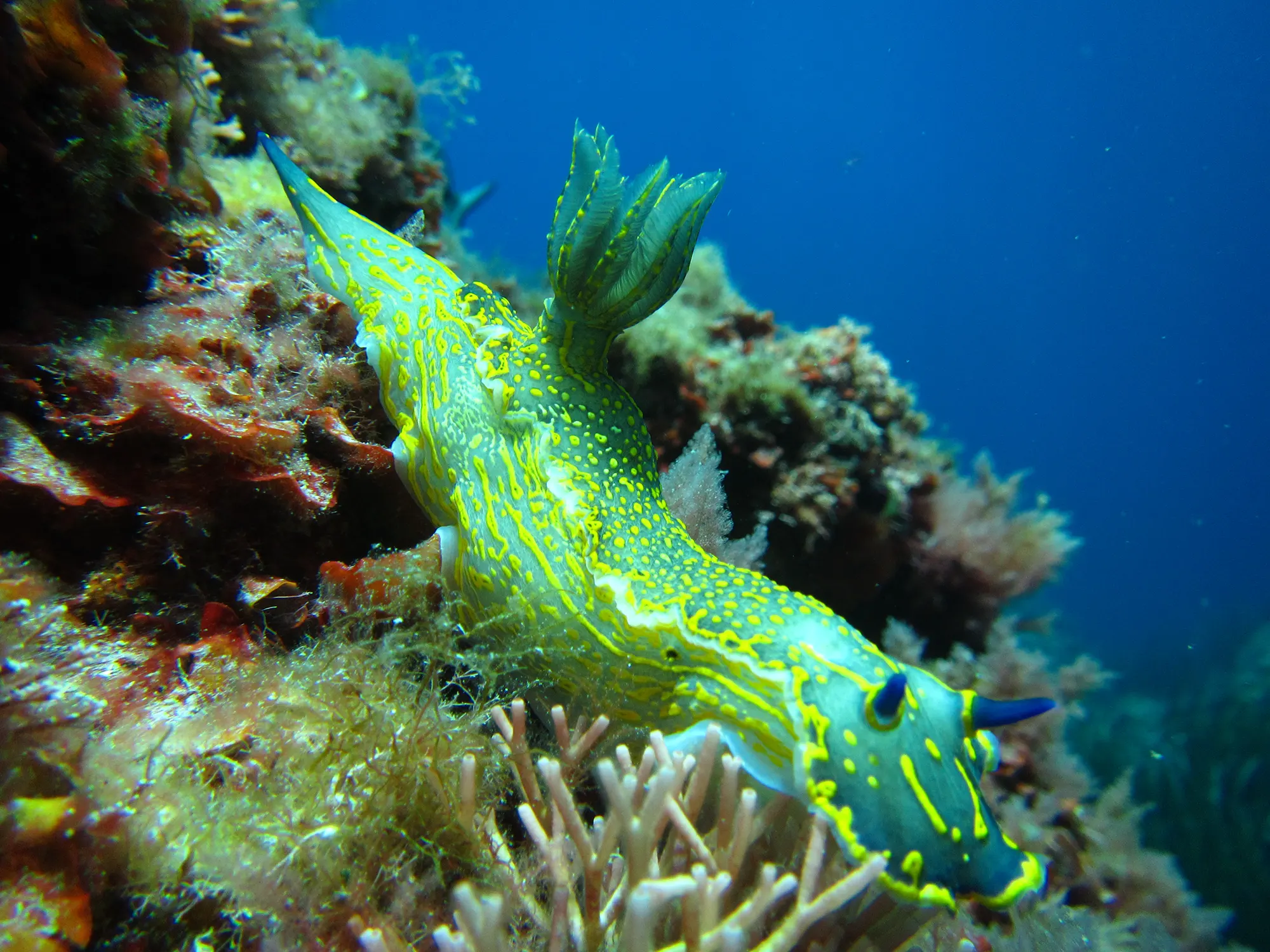
Diver's Playground *
Giant rocks and stones, combined with a steep wall, guarantee an unforgettable dive. Everywhere we find tunnels, small caves and canyons. In between the rocks we can find moray eels, octopus, trigger fish and colorful nudibranchs, while on the sand it is possible to spot stingrays, eagle rays and flying gurnards. An ideal place for photographers, as there is plenty to explore here. Many of our divers tell us that one dive is not enough to see everything.
Depth: 8 - 21 metres.
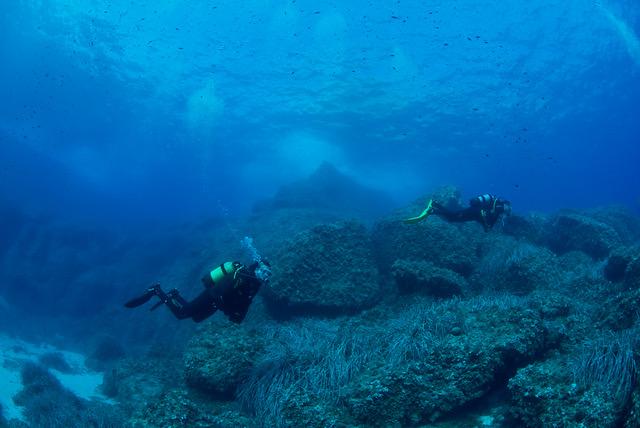
Los Bloques *
We jump into the water in a beautiful sheltered bay in Cala'n Blanes. Swimming towards the sea, the depth of the bay gradually goes from 3 to 10 metres, after which we reach an impressive abyss at 18 metres. Going to the left, we see several groups of huge boulders, that reach from 18 to 7 metres. On the way we can find octopus, moray eels and nudibranchs, while the boulders are a gathering point for large schools of fish and barracudas. Visibility here is often excellent and with some luck we can even spot large tuna!
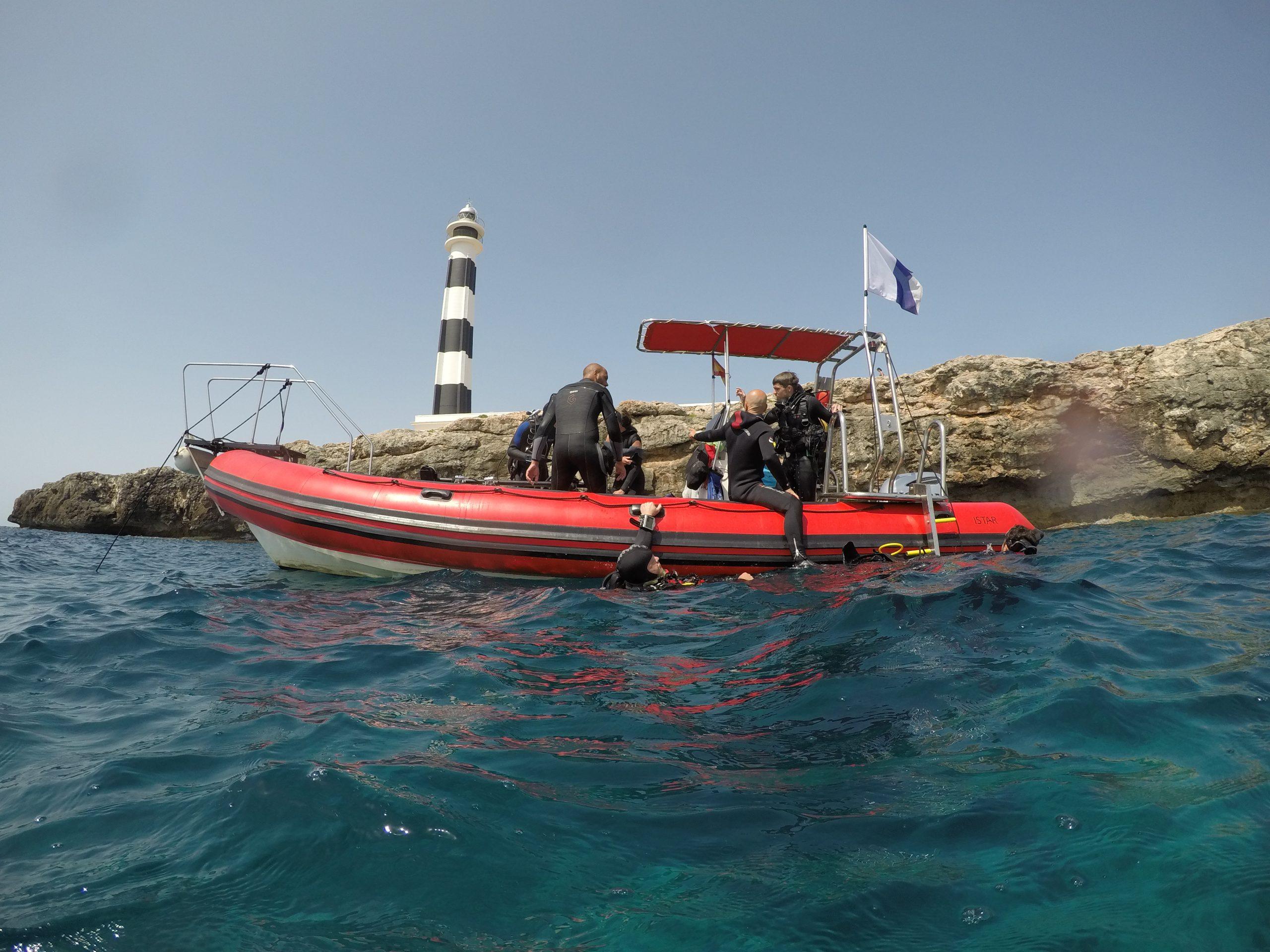
Faro d'Artrutx *
We usually frequent this spot as a repetitive dive after diving the 'Malakoff' wreck. Below the lighthouse of Cap d'Artrutx we find a landscape with canyons, steep walls, overhangs and small caves, as well as a wealth of marine life.
In May and June, large stingrays can be observed as they come here to mate.
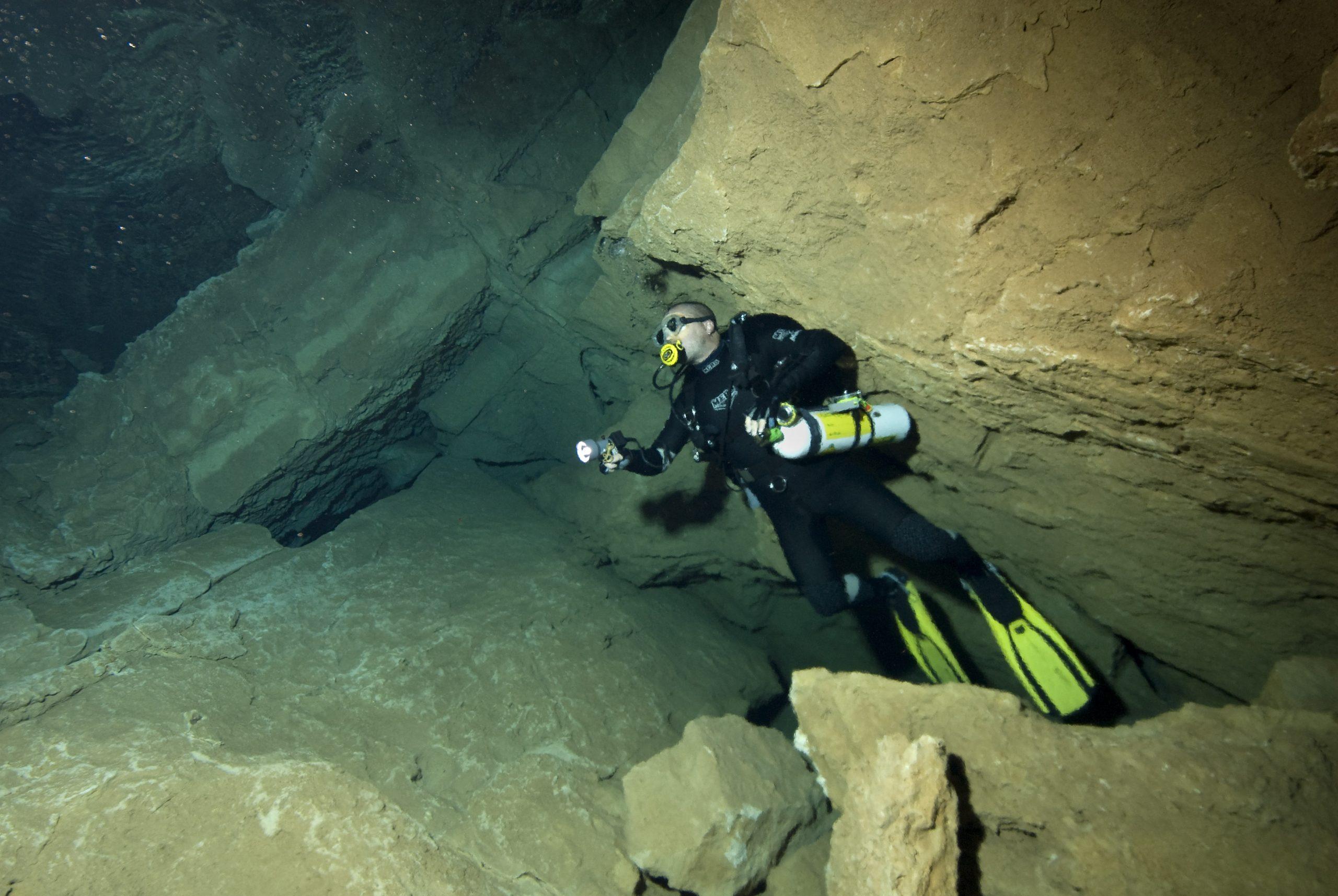
Fossil Cave ****
Another attraction on Menorca's south coast. At the end of a large overhang, at a depth of 13 metres, we find the letterbox openings that lead to this cave. Once inside the cave opens up into a large room, filled with hugh rocks that have fallen from the ceiling at some point. The visibility inside usually equals that of the cenotes in Mexico! Following the left side we can surface in a small air pocket, after making a safety stop and emerging through a freshwater halocline. Looking up at the ceiling we can see the fossile remnants of hundreds of shells, where this cave has gotten its name from.
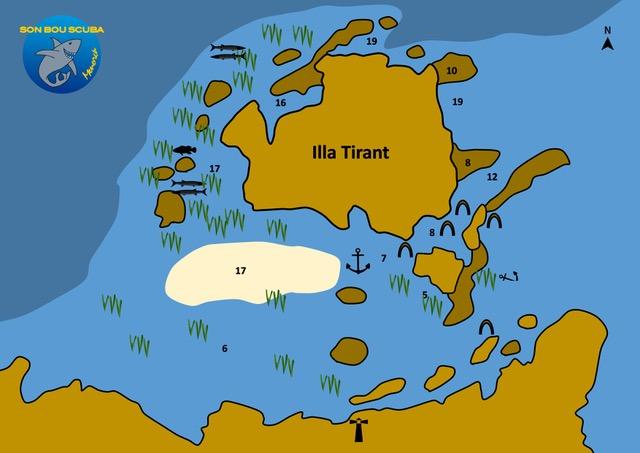
Isla de Tirant * (marine reserve)
We anchor the boat in a sheltered bay at a depth of about 5 metres. After entering the water, we keep Isla de Tirant to our right. We follow a drop-off that leads to a sand bottom at 18 metres. As we do so, we can spot pipefish, moray eels and octopus. Once outside the bay, we can see schools of barracuda, sea bream and amberjacks, as well as small tunas.
We continue our dive with the reef to our right, until we reach a wall that leads us to a labyrinth of gullies and canyons. As we swim between the canyons, we encounter a beautiful arch that takes us back to the bay where the boat is moored.
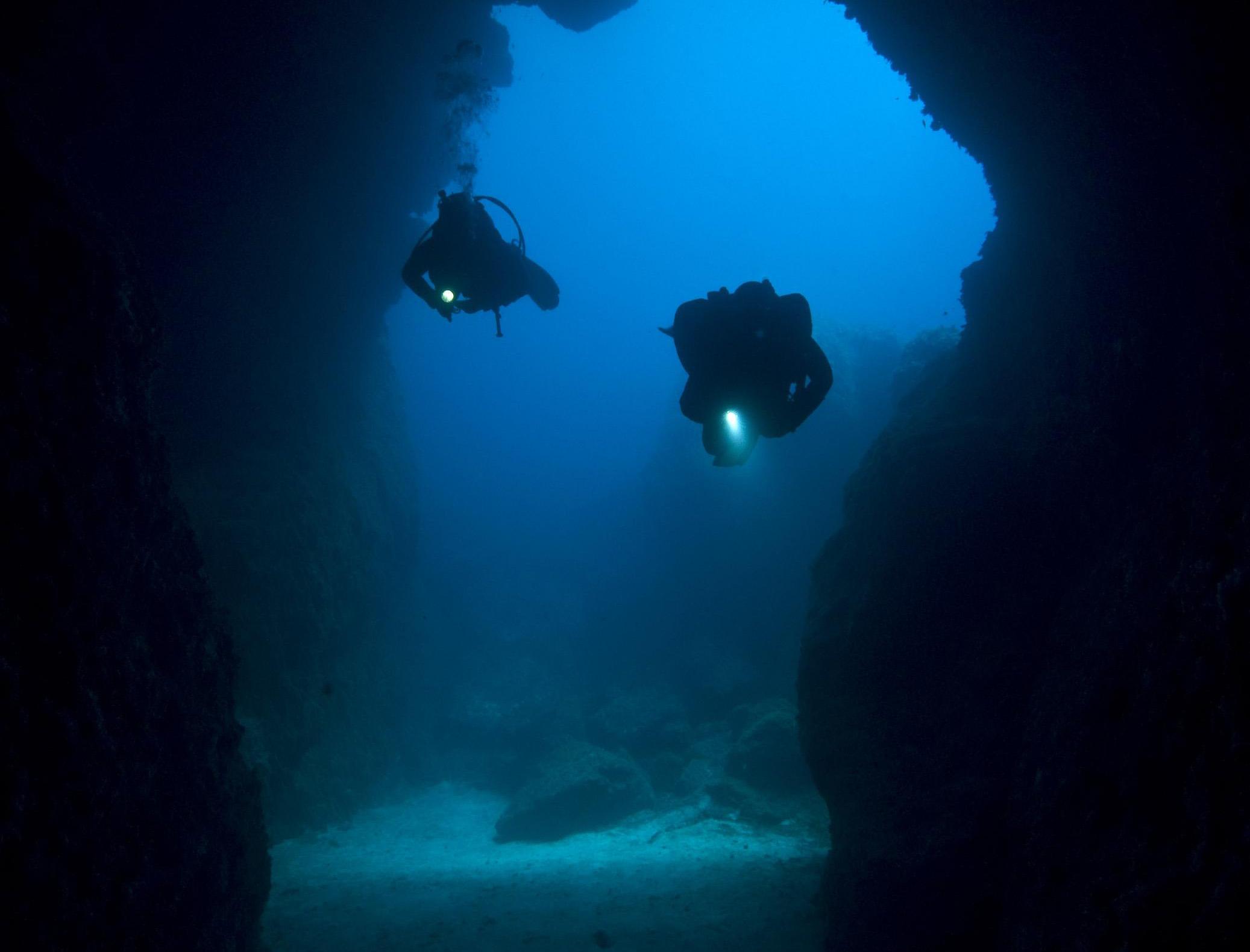
Horse Shoe Tunnel **
The Horse Shoe is a tunnel with a 90-degree angle. After a wide opening, the tunnel quickly narrows and ends in a chimney. Here we swim up a few metres, searching for shrimps and crayfish in the meantime. After reaching the ceiling of the chimney, we can see the exit of the tunnel and enjoy the fantastic backlight that floods in.

Junkers 88 wreck ****
On February 24, 1943, this German Ju-88 A4 light bomber, stationed in Sicily, accidentally veered off course after a raid on targets in Algeria. Upon sighting the Isla del Aire lighthouse and with little fuel available, the pilot decided to make an emergency landing in the sea, in front of a trawler with local fishermen. All four crew members survived the landing.
The aircraft is now resting at a depth of 47 metres. Because of the depth and the often strong current, this is not an easy dive. We plan this dive on request, in cooperation with one of our partner dive centers.
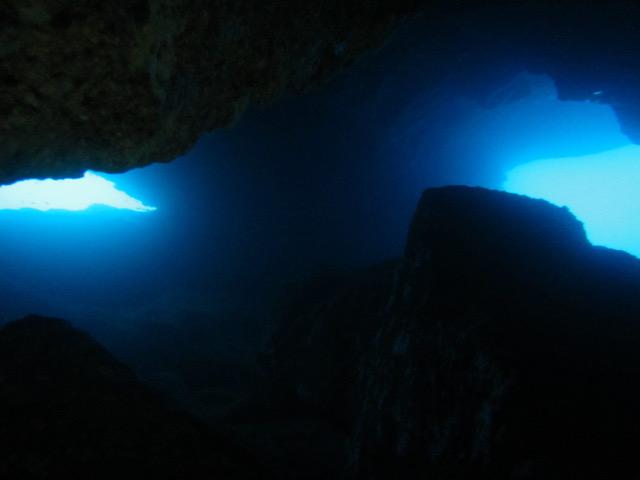
Labyrinth */**
Labyrinth, also known as ‘Grand Canyons’, is a dive site located on the west coast. Following the rocky entrance we jump into a fantastic sinkhole, from where we will follow the cliffs that lead us to the entrance of a marvelous cavern. Inside, we swim through a halocline and find a tunnel leading further into the coast. Experienced divers can go there and look for
crustaceans, after which we’ll reach a letterbox exit through which we exit the cavern.
Following the coast further to the left, we’ll enter an underwater labyrinth of canyons and tunnels, while reaching a maximum depth of 20 metres. Labyrinth is a great place for underwater photographers.
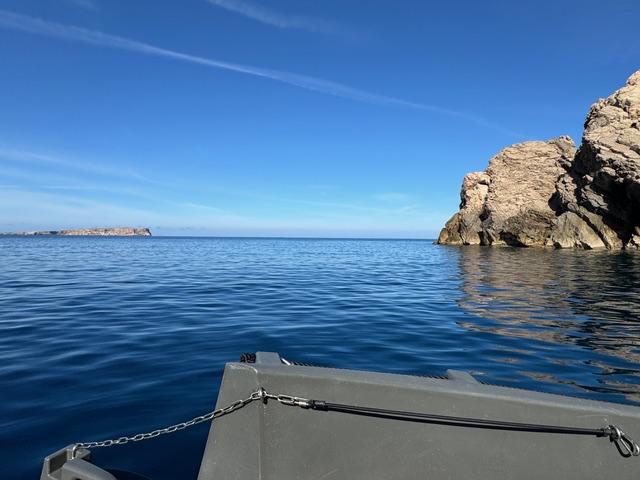
Punta Lajial * (marine reserve)
A dive site discovered in 2023 that has brought us some great surprises. After anchoring we let ourselves fall into the sea to a depth of about 15 metres. While we swim towards a channel we usually see moray eels, sea breams, small groupers and some octopus in their hiding place. Approaching an area of sea grass, we turn right to a rocky area at a depth of about 18 metres. Following the rocks, we come to a terrace at a depth of 23 metres and from there to a drop-off that goes to about 34 metres. Here, besides large groupers, it is common to find spiny lobsters hiding in the crevices of the rocks.
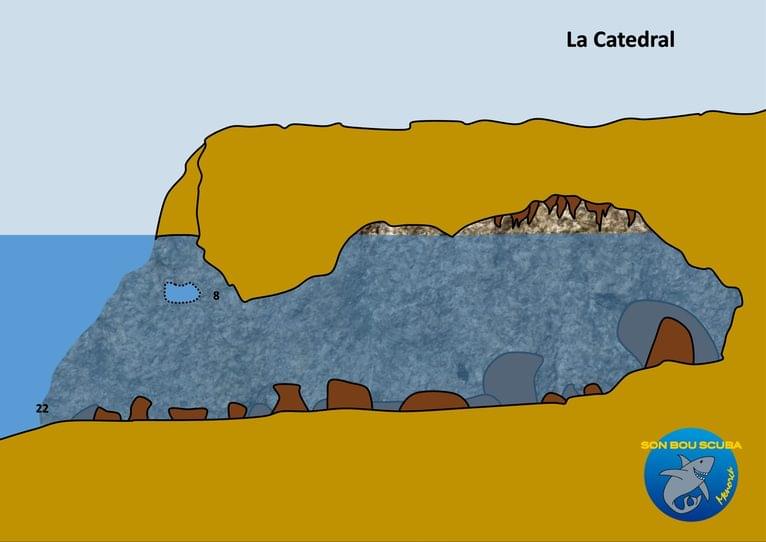
Cathedral **
Beautiful cavern with an immense opening from 6 to 21 metres. Cathedral is the largest underwater cavern on the south coast, and ideal for divers with little experience in cavern diving. When we swim into this cavern, we follow the left wall and via large boulders and columns we end up at the back. Here is another circular room with stalagmites, which we only visit if the divers have sufficient experience. If we now follow the other wall, we have a fantastic view of the opening of the cavern. After a safety stop, we surface into a large air bubble and see the stalactites hanging from the ceiling above us. When we turn off our dive lights, the light from outside gives the cavern a blue color. Certainly one of the best dives in Menorca.
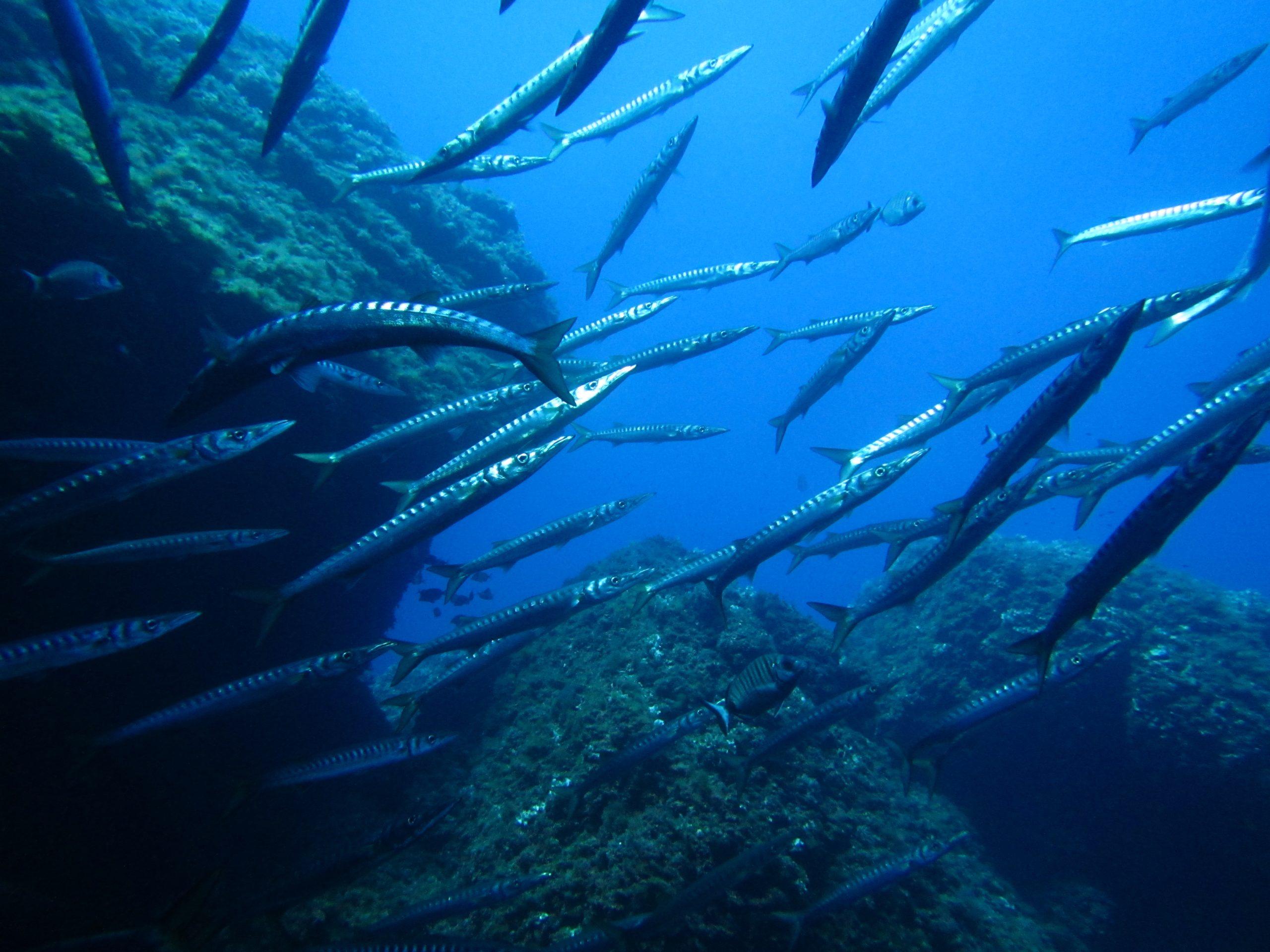
Llosa del Patró Pere ** (marine reserve)
La Llosa del Patró Pere is considered to be among the best dive sites in the Northern Marine Reserve. We reach La Llosa, which is located in the centre of the reserve, by boat.
Following a canyon, we eventually reach a large arch at 22 metres, where we encounter a group of approx. 150 barracuda’s. After we have enjoyed the barracuda's, we continue our way to the left and make a tour around an underwater hill. Large groupers, amberjacks and sometimes tuna can be spotted here. Max. depth: 30 metres.
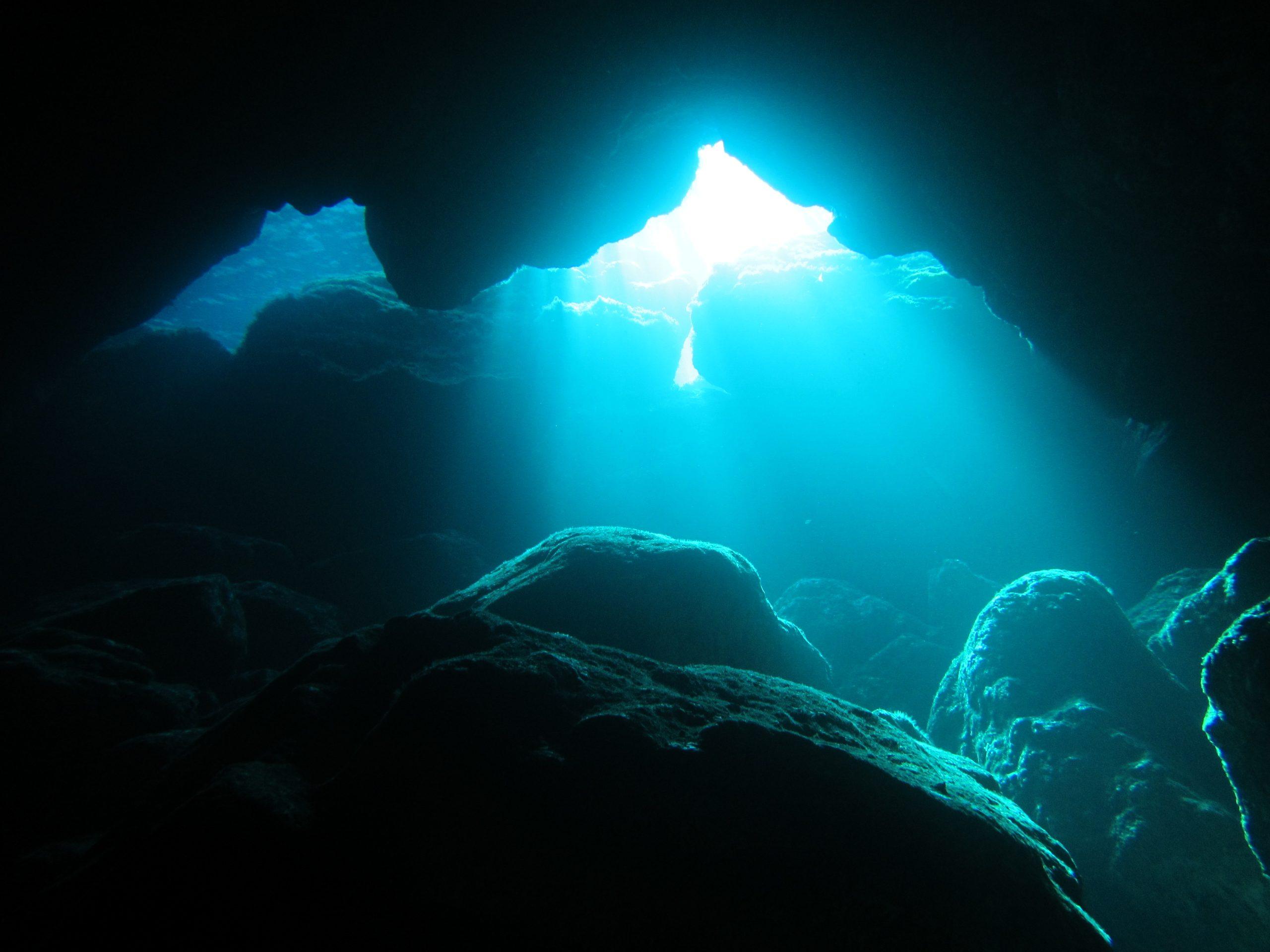
Lightning Corner I **
This dive site is located on the north coast just outside the marine reserve. We anchor the boat near a huge rockfall created long ago by a lightning strike - hence the name. As we follow the reef, we find the entrance to the first cave, which opens into a large chamber with openings to the surface that give a beautiful backlight. This cave is connected by a tunnel to a second cave. After leaving this cave, we visit a third cave, with an exit on the left and a tunnel running parallel to the shore. Here we find shrimps, small conger eels and crabs. We follow this tunnel to the end, where we can emerge into a chamber.
After leaving the cave, we find a seabed full of large rocks which allow us to dive underneath and then swim out through another opening.
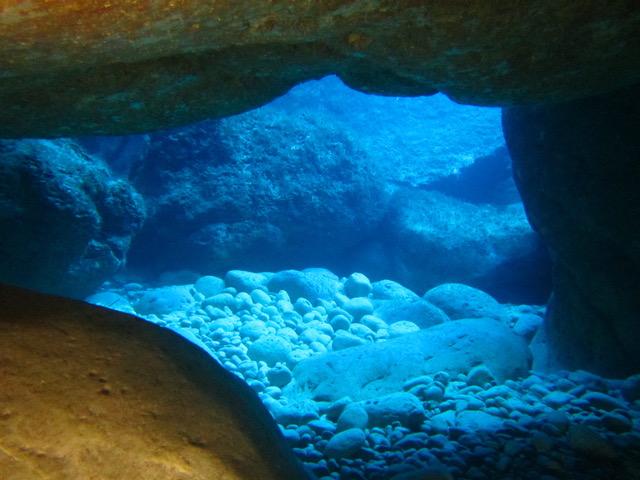
Lightning Corner II *
Leaving the boat, we descend towards the seabed to a depth of 15 metres. Here we find large boulders that allow us to dive underneath them. After ten minutes we arrive at a large round hole in the bottom that descends to a depth of 20 metres. Inside are several overhangs, some with slipper lobsters and spiny lobsters in them. Diving to the right, we pass through a huge archway. Looking back towards the arch, we can see the other divers in a spectacular backlight. We then dive back through the archway and swim into a cavern. Once inside, we surface and can see the ceiling some 30 metres above us. After admiring the cavern, we continue our dive and visit two more small caves.
Arriving at this point of the dive, we slowly ascend and swim away from the reef for our safety stop.
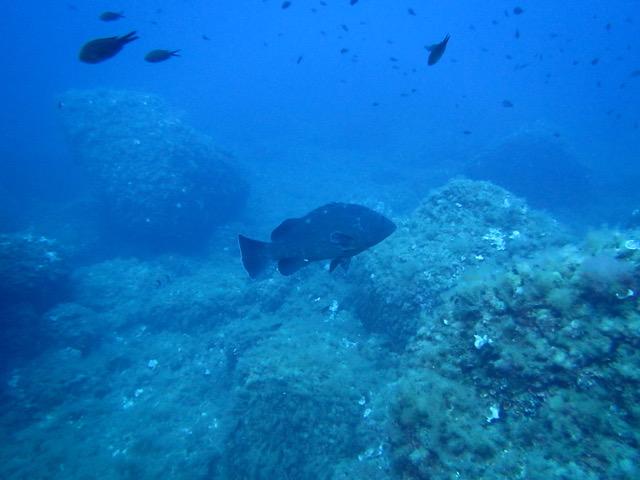
Isla de Porros ** (marine reserve)
Isla de Porros marks the northern boundary of the marine reserve. Thanks to an underwater landscape with drop-offs and large groupers, schools of amberjacks and barracuda, this is one of the best dives in the reserve.
We anchor the boat on the south coast of the island, at a depth of 10 metres. While descending to 20 - 25 metres, we see large boulders that provide shelter from the current. Here we can often observe barracudas. At a depth of 30 metres, we reach a cluster of rocks where a family of large groupers lives.
Slowly approaching the southwestern tip of the island, we turn around before the current pushes us around the corner. As we swim back along the reef, we search among the rocks for archaeological remains: the area is full of ancient remains such as stone anchors and amphora shards.
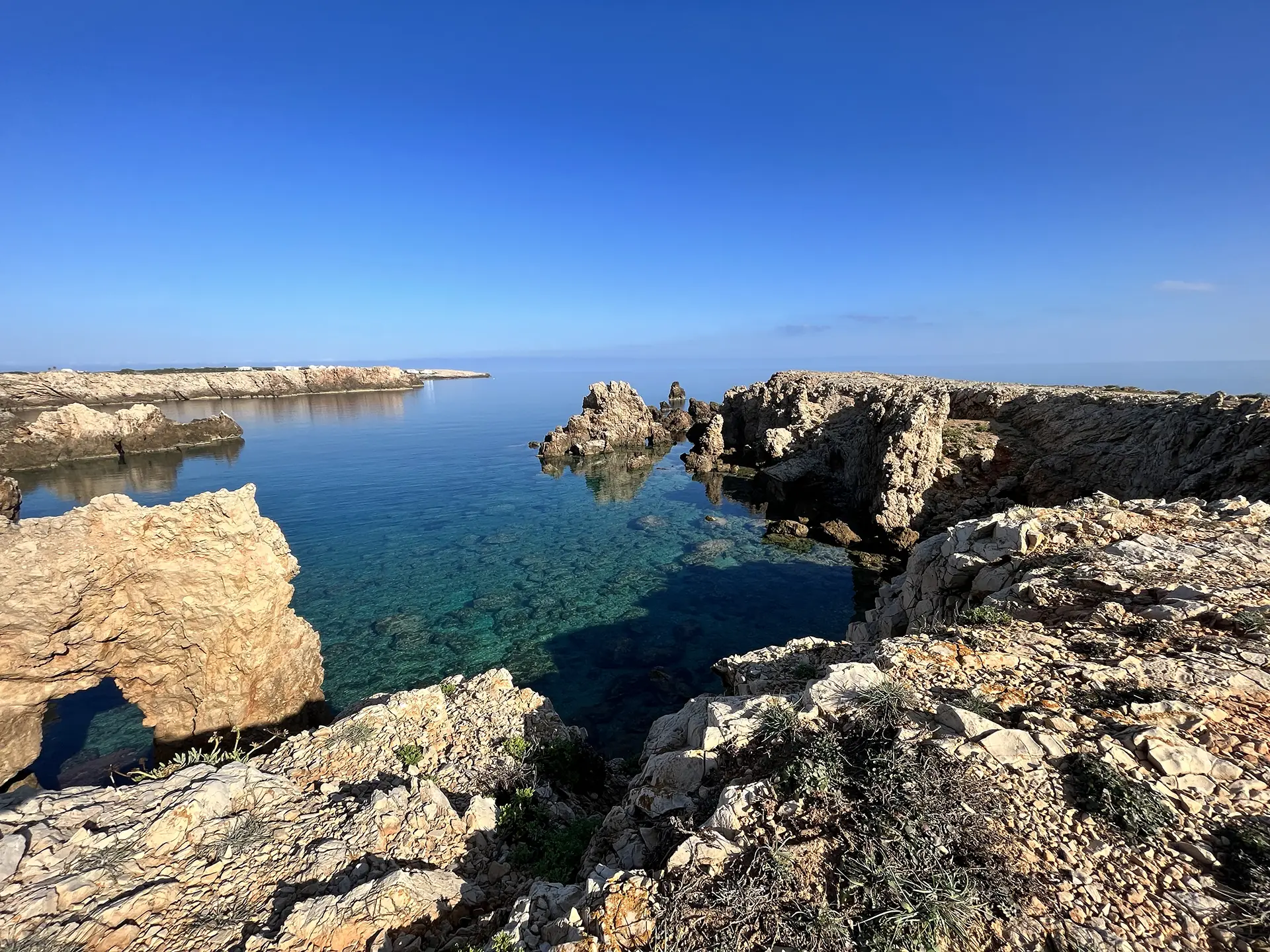
Macaret Point *
The typical steep walls of Menorca's north coast continue underwater here, guaranteeing a beautiful underwater environment. Small canyons and tunnels, combined with large schools of fish, provide an ideal backdrop for underwater photography. A large group of barracudas has its territory here. Excellent land dive when the wind blows from the south. Depth: 10 - 22 metres.
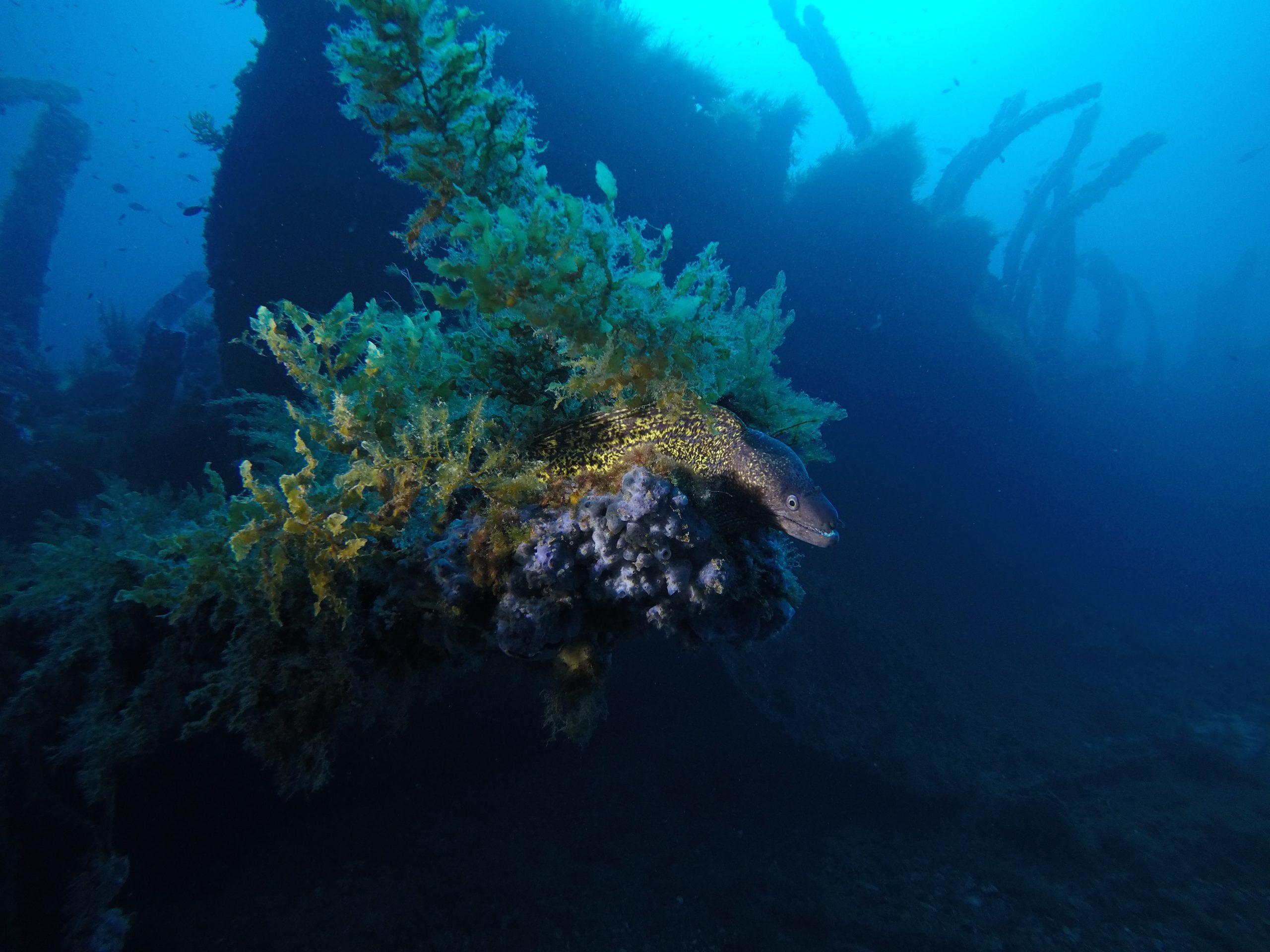
Malakoff wreck ***
During a storm in January 1929, the French steamship Malakoff ran into a rock formation known in Menorca as 'Escull de Gobernador' and sank in just 7 minutes. This famous wreck stands upright on the sandy bottom, at a depth of 40 metres. The deck is located at approximately 32 metres. In the 1950s, salvage divers blew away the entire superstructure with explosives. Today, the Malakoff forms an artificial reef some 105 metres long. Because around the wreck is only sandy bottom, we find an unprecedented abundance of fish here, which also attracts many pelagic fish. A group of more than 100 barracudas has its permanent home here. We also see conger eels, large grouper and triggerfish. Sometimes divers can find remains of the cargo; ceramic tiles and porcelain.
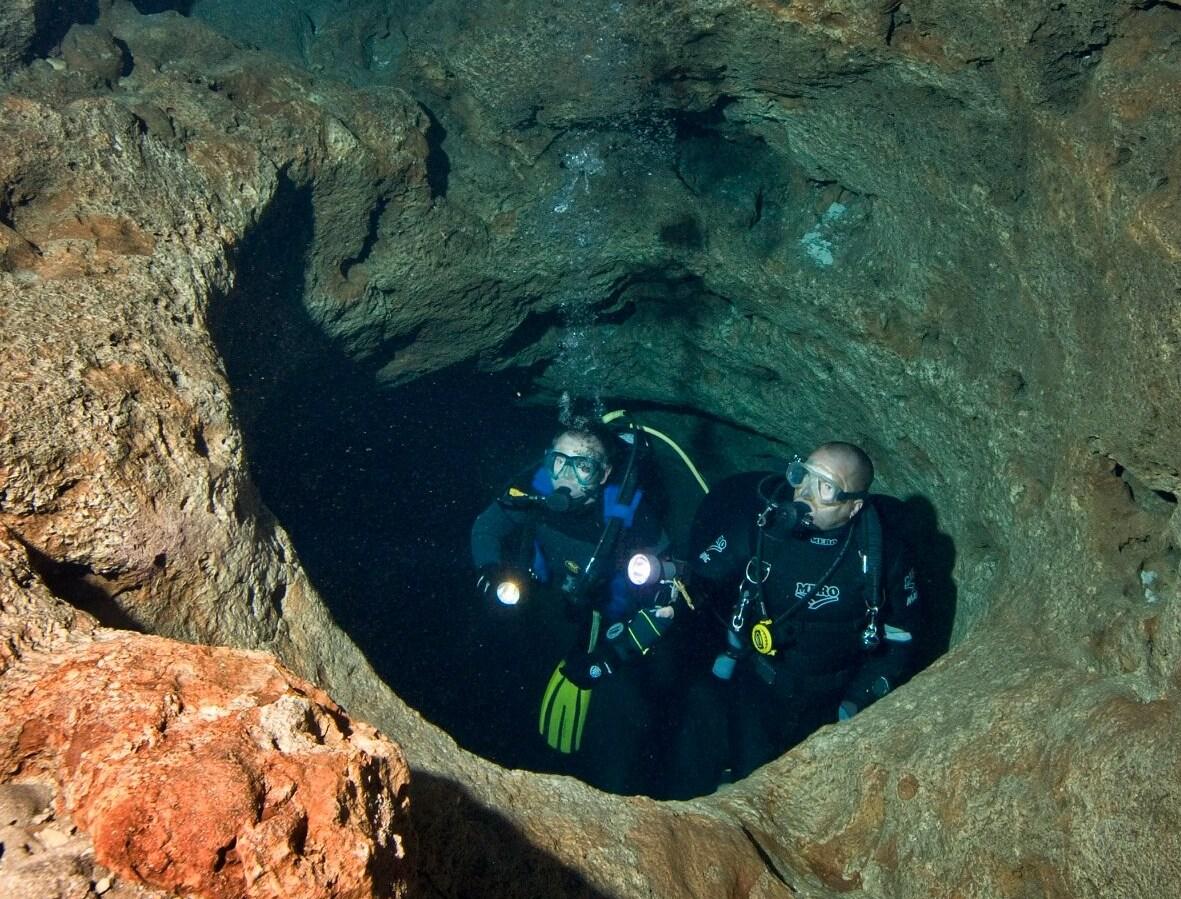
Moon Pool ***
A beautiful steep wall takes us to the entrance of Moon Pool, located at a depth of 13 metres. Moon Pool is one of the most famous caves in Menorca. Once inside, a tunnel leads us via several bends about 50 metres into the rocky coast of Cap d'en Font. As we follow this tunnel, we swim over large boulders and round pebbles, until at the end we reach acircular room with a hole in the ceiling. Here we make our safety stop, after which we swim through a halocline before surfacing. After a final bend, we are now in a small air pocket.
On the way back, we look for conger eels, crabs and shrimps, which we find here in abundance.
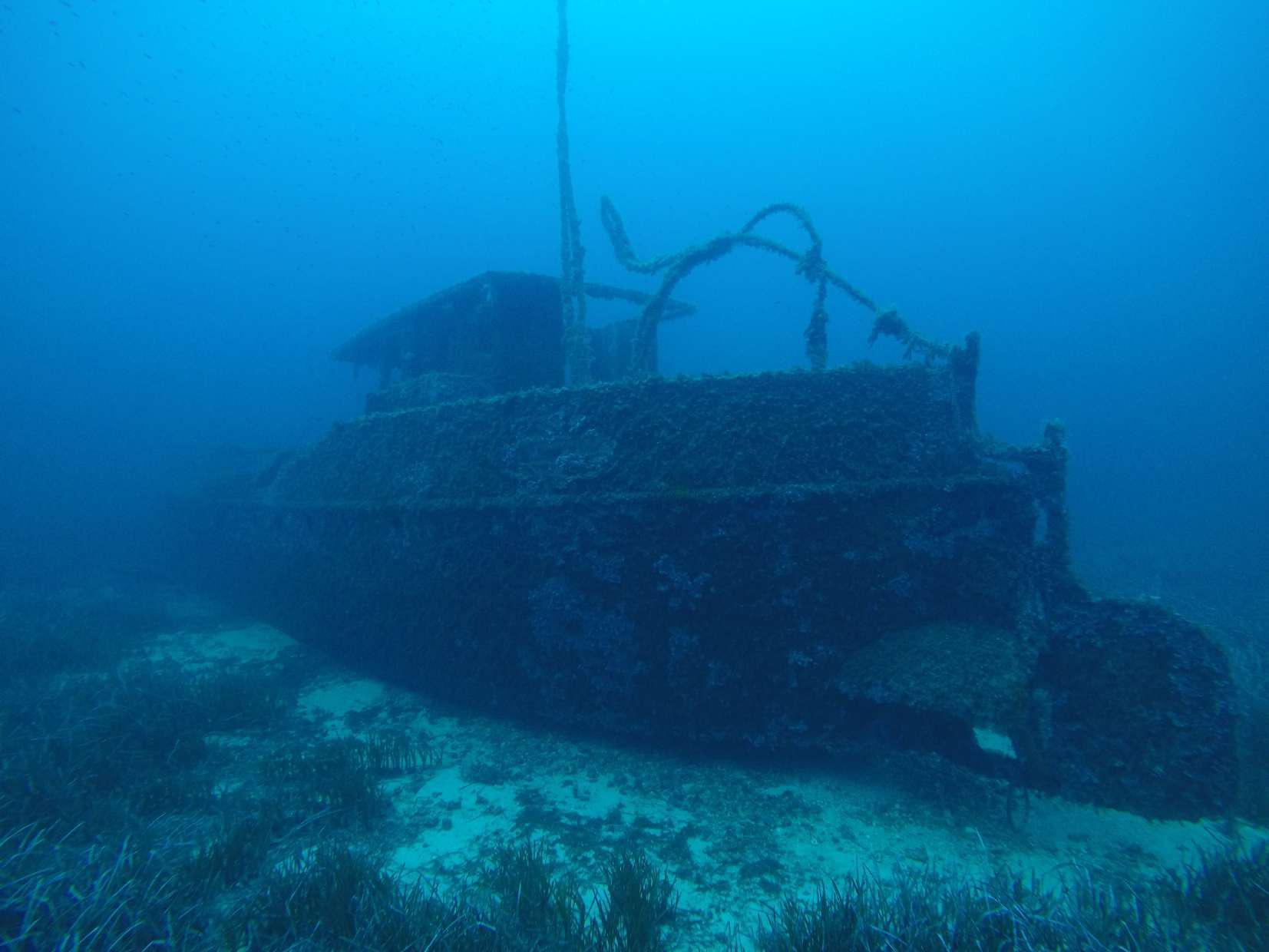
Ocean Diver wreck **
The Ocean Diver is a small Dutch freighter about 23 metres long. The
was last used for tobacco smuggling between several Mediterranean ports
and North Africa, and eventually impounded by the Spanish Coast Guard. After
several years of rusting in the port of Mahón, the Ocean Diver was made into a
sunk to create an artificial reef.
Directly in front of the dive centre, the wreck sits
upright on the sea floor at a depth of 28 metres and provides a habitat for
groupers and nudibranchs.
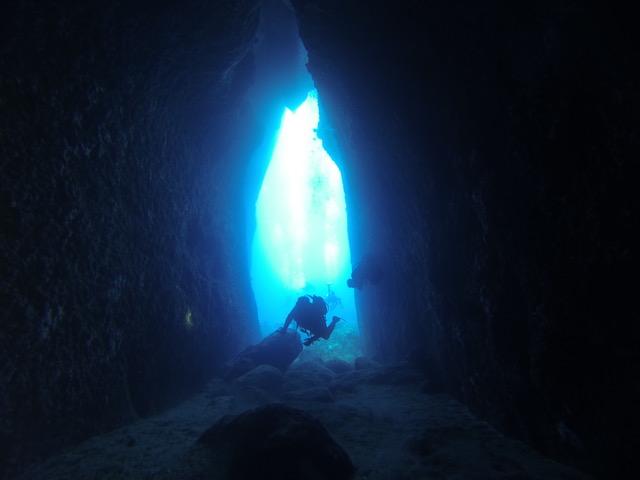
Puerta de la Iglesia ***
We find this cave after leaving the cove of Cala’n Forcat. Following the reef, we enter the cave while staying away from the sandy bottom, as a wrong fin kick can bring visibility down to just a few metres! The cave goes straight into the shore, and slowly gets narrower and the ceiling lower. About 100 metres in we come upon a restriction with some stalactites and stalagmites, which is proof that once this was a dry cave. From here onwards, access is only possible with sidemount-configuration, so we turn around. While swimming back, we search for crustaceans and enjoy the blue from the opening, which resembles a church door. A truly amazing sight!
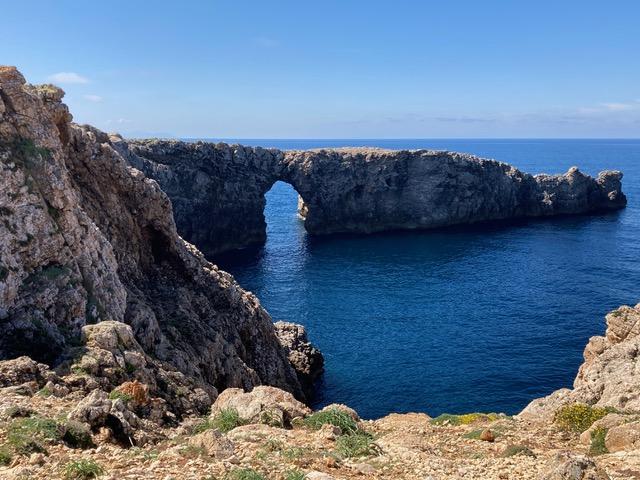
Punta de S' Alemanya *
This dive site is located next to the famous Pont d'en Gil cavern. We anchor in a sheltered bay and after dropping into the water, swim in the direction of the arch at a depth of 10 metres. We follow the reef on our right until we see a tunnel in the wall and enter. Once we exit the tunnel, we are outside the bay and dive down towards the seabed at a depth of 20 metres. Here we follow the boundary of sand and rocks, looking for groupers, moray eels and octopus. On the sand, we look for stingrays and eagle rays, which we often observe here. While looking for marine life in the many overhangs, we swim around the headland and return to the bay where the boat is moored. A truly beautiful dive with often excellent visibility.
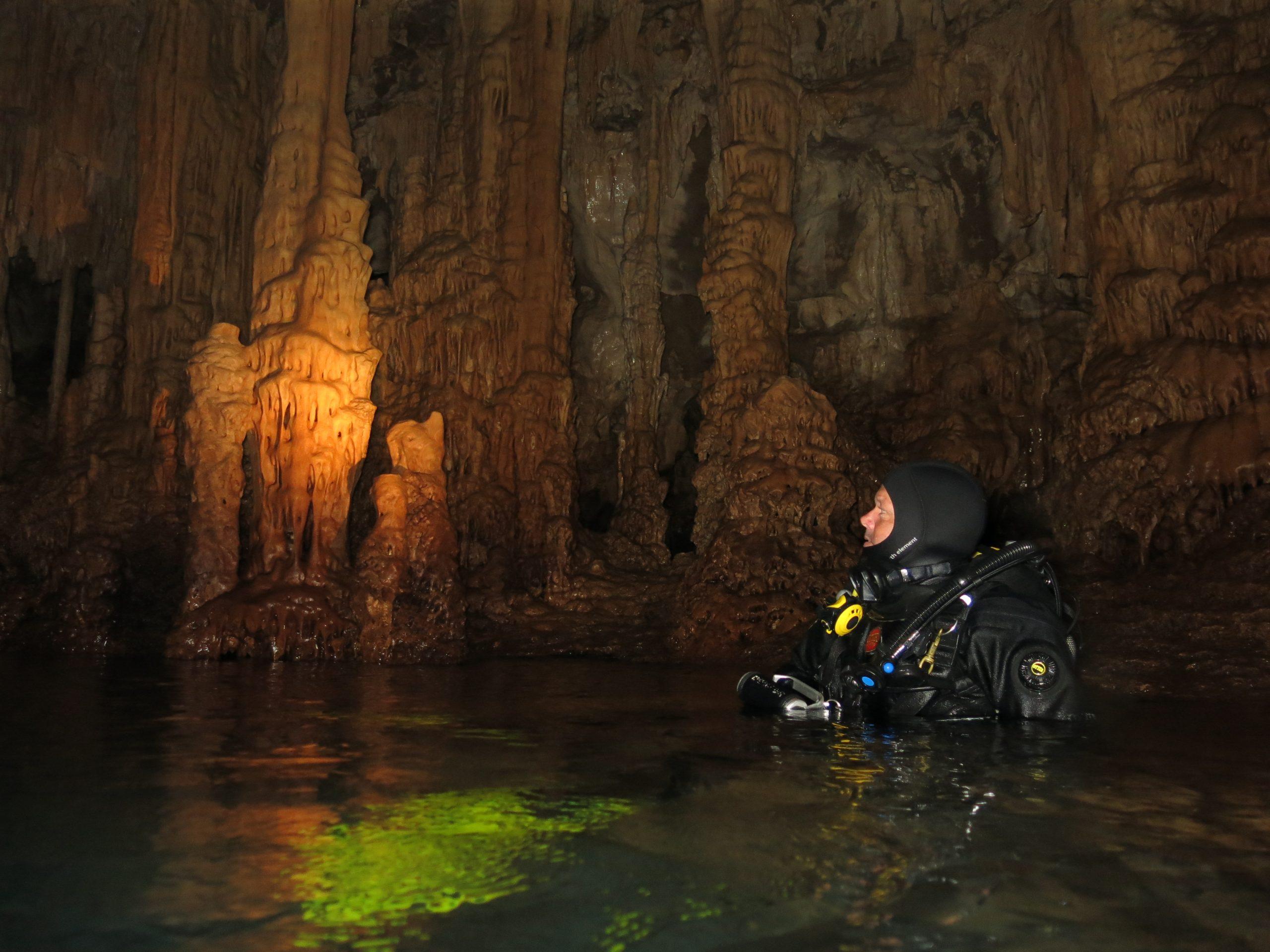
Pont d'en Gil */**
At 220 metres long, Menorca's most famous cavern is not to be missed in any logbook! Pont d'en Gil is filled with stalactites, stalagmites and columns. With a maximum depth of 12 metres and because it is almost always possible to surface, this cavern is also suitable for less experienced divers.
After anchoring in the nearby bay, we swim underneath an arch. Soon we can see the opening to Pont d'en Gil and enter a large tunnel. Once inside, floating on the surface, we admire the stalactites above us. With experienced divers, we can access a second cave at the end of the tunnel. No stalactites here, but “English Beach”. The way back is underwater and we leave the cavern via a small tunnel, which brings us back into the bay where our boat is moored.
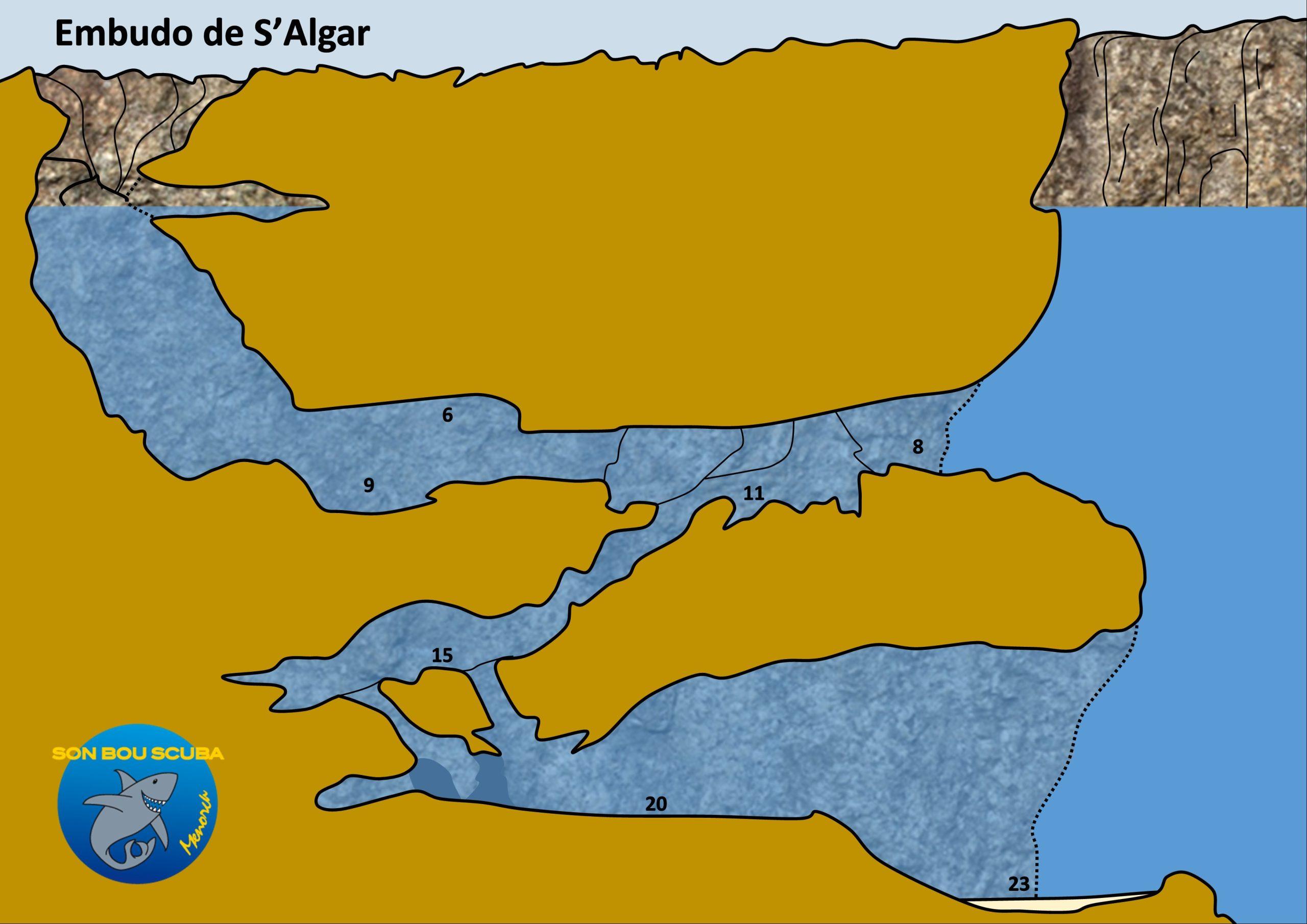
S'Algar Funnels **
Two spectacular caverns on top of each other, connected by a tunnel. The upper cavern, with it’s entrance at 8 metres, leads to a small sinkhole in the rocky coast of S'Algar. After we have enjoyed the spectacular entrance of light from the sinkhole, we swim halfway where we can see the tunnel that will bring us to the lower cavern. The semicircular opening of the second cavern is so large that daylight reaches into the back. The maximum depth in the lower cavern is 26 metres. Once outside we can reach a depth of 30 metres, before starting our ascent along the wall.
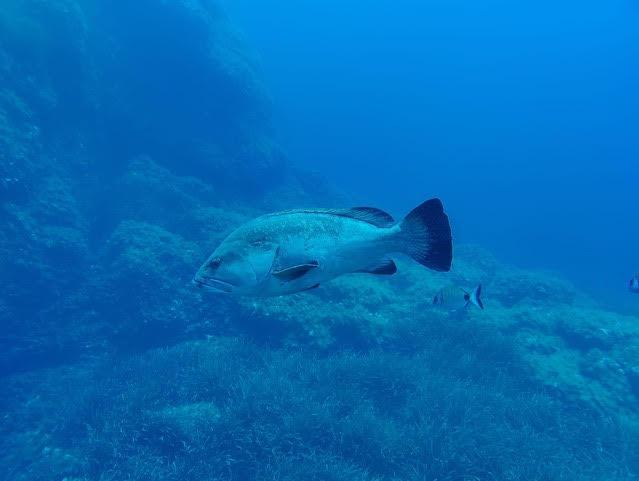
S’ Olla */** (marine reserve)
This sheltered bay at Cap de Cavalleria offers dives for all levels, as we can easily adjust the depth to the divers' experience level.
The easiest dive takes us along the south wall of the bay, swimming between boulders at depths ranging from 8 to 18 metres, where we can see medium-sized groupers, bream, moray eels and octopus.
The other dive we do in this bay is only suitable for experienced divers, as we can reach a depth of 40 metres. Swimming northwards, we find ourselves among large boulders, which are a refuge for morays and spiny lobsters. The deepest area, at 40 metres, is where the biggest groupers live. After turning around, we ascend to a shallower depth and follow a cliff face. Here we swim between boulders that form tunnels in the reef, until we reach the boat again where we conduct our safety stop.
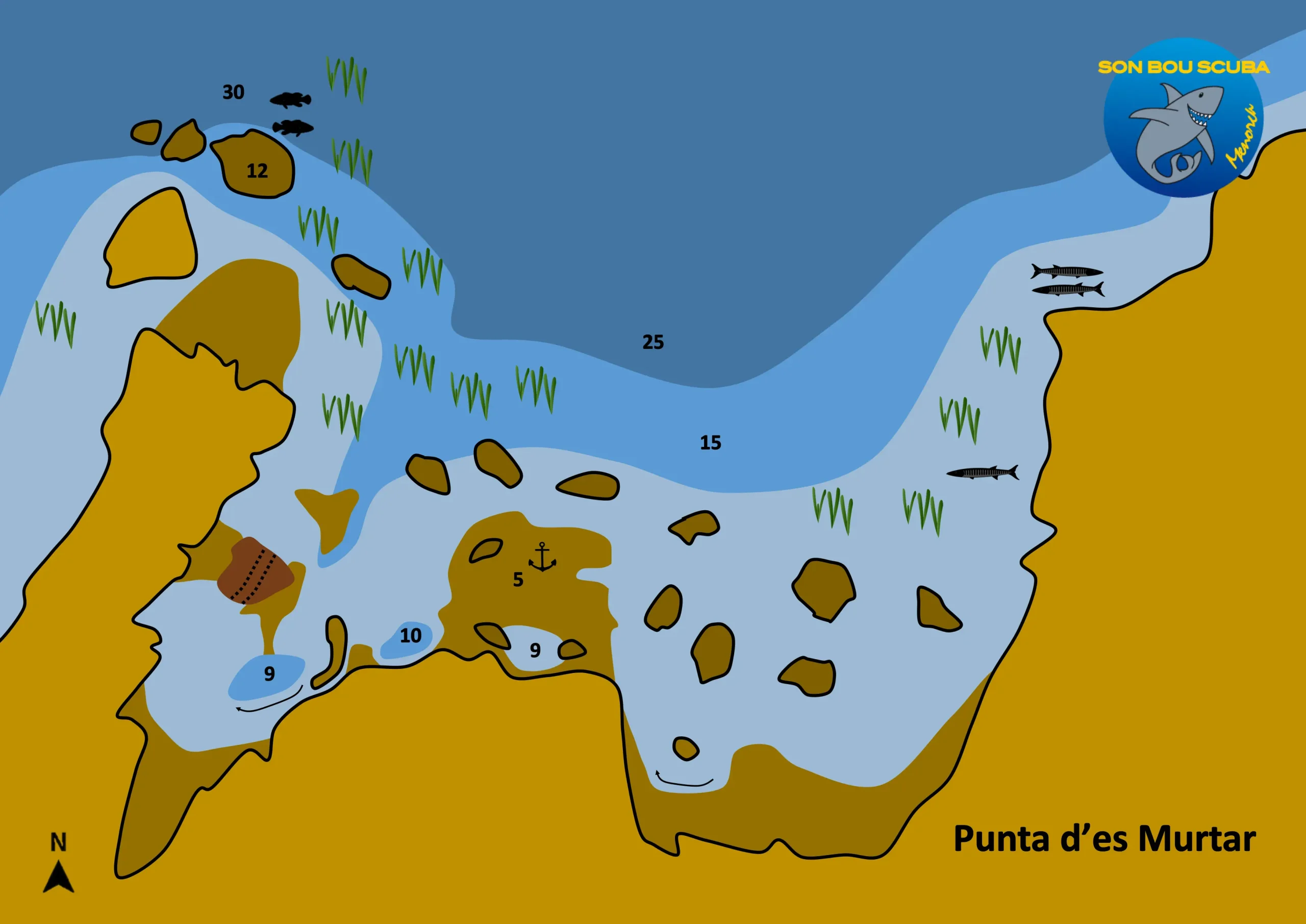
Punta es Morter * (marine reserve)
Punta es Morter offers us a unique landscape with a surprising amount of marine life. After anchoring the boat, we follow the edge of the reef at a depth of about 15 metres until we see a spectacular underwater hill. On the western side of the hill, we can reach a depth of 28 metres. It is here that we see the greatest concentration of life; groupers, schools of bream, amberjacks, moray eels and sometimes bonito. The hill itself is usually covered with colourful nudibranchs. After swimming around the hill, we return to the reef and enter a beautiful gully that leads us to a series of small tunnels. After swimming in and out of the tunnels, we again follow the edge of the reef to look for a school of barracuda, which are often to be found here.
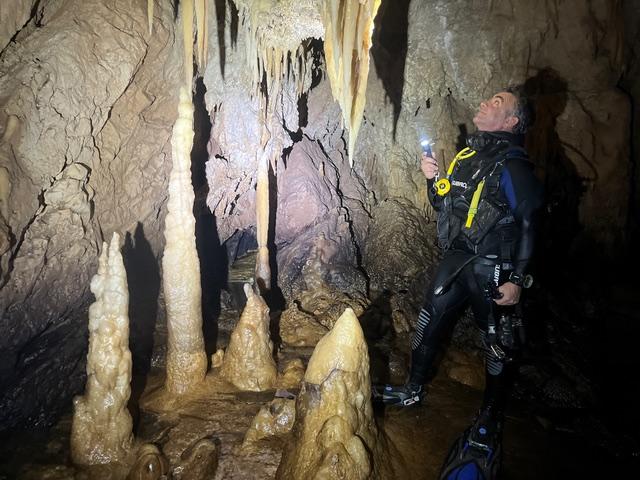
Stalactite Cave **
Stalactite Cave, located on the north coast, is a small cavern that was discovered only recently and that is known to very few people. A small entrance leads us via a tunnel to an air-filled space, where we can surface. If we look over our shoulder, we can still see the blue from the entry. Inside it is shallow and we can swim around a large rock. To the left there is another room full of stalactites and stalagmites. To reach this, we have to take of our fins and wade through a large crack. Here we can enjoy the true beauty of this cavern -without touching anything-, as the process of precipitation is still on-going after thousands of years.
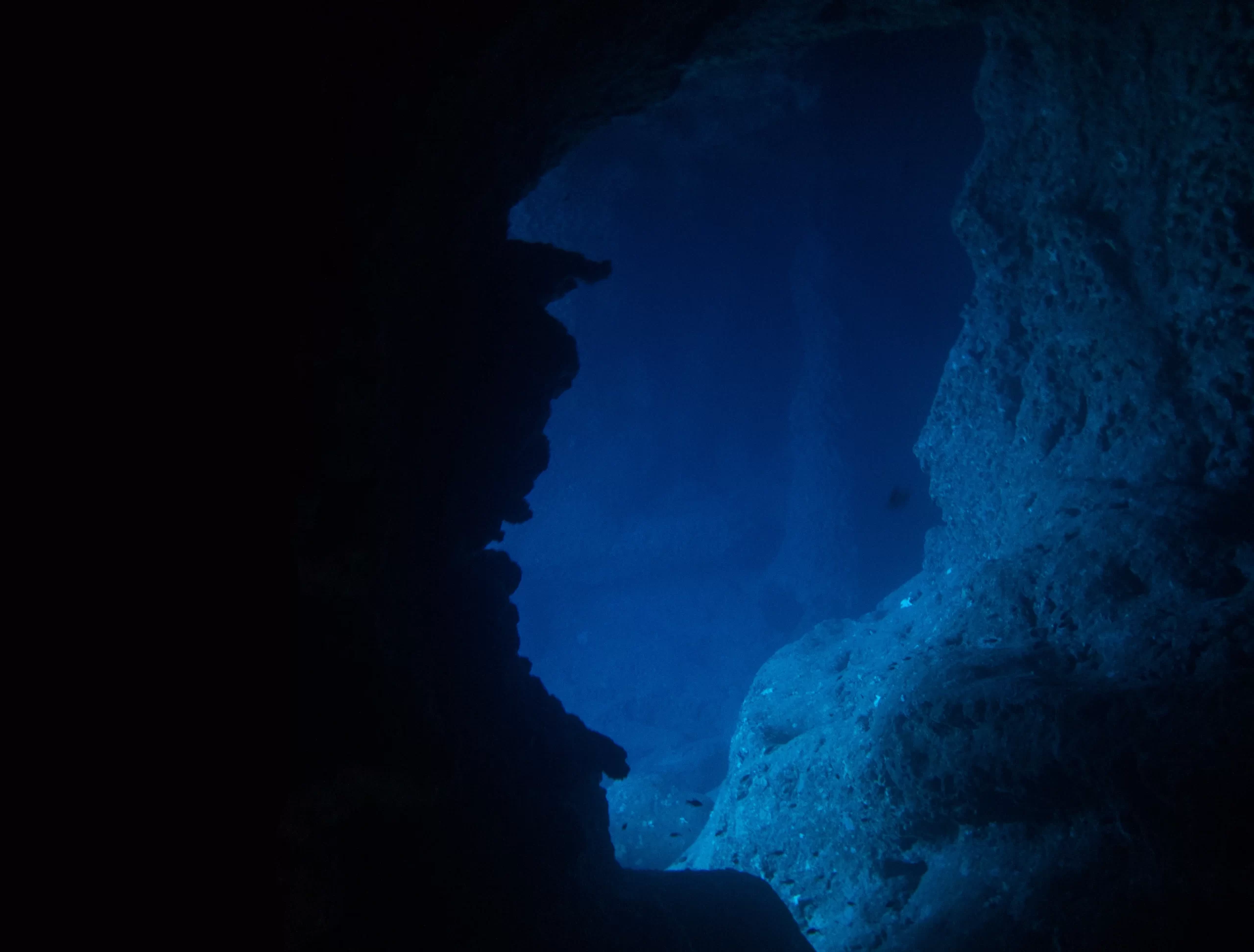
Scorpion Cave ****
This tunnel in Cap d'en Font is hardly known and even less explored. After we enter a small cave in the rock face we follow it to the right where we find a narrow passage in the bottom. Behind this restriction we can see a tunnel that emerges some 150 metres further into the 'Belltower'. Scorpion Cave is best dived in sidemount configuration. Depth: 5 -18 metres.
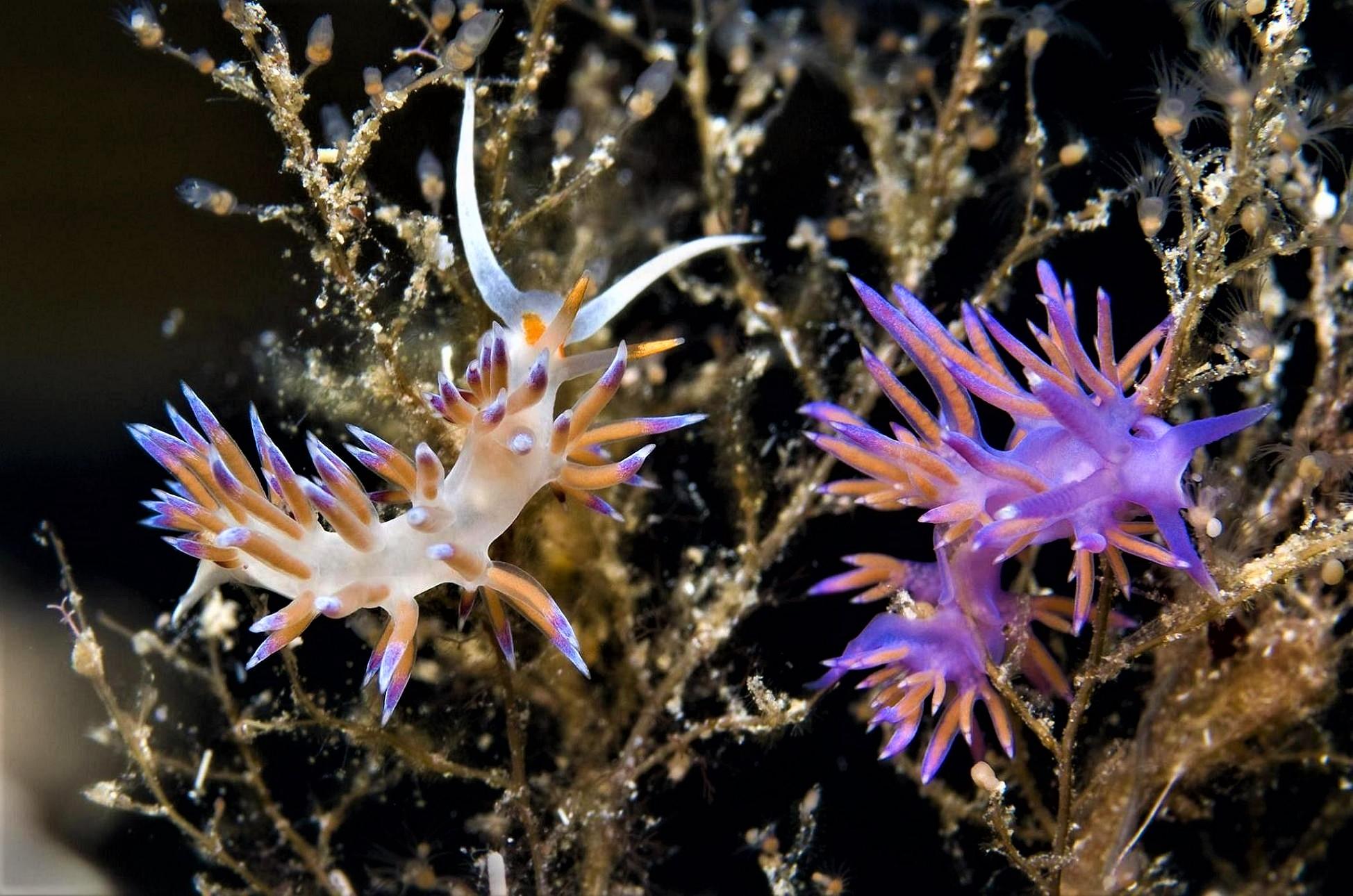
Seven Arches *
The underwater landscape of this dive site is a real surprise! A labyrinth of different canyons, tunnels, steep walls and overhangs make it playful. Due to the shallow depth (max. 13 metres) an easy dive and very suitable for underwater photography.
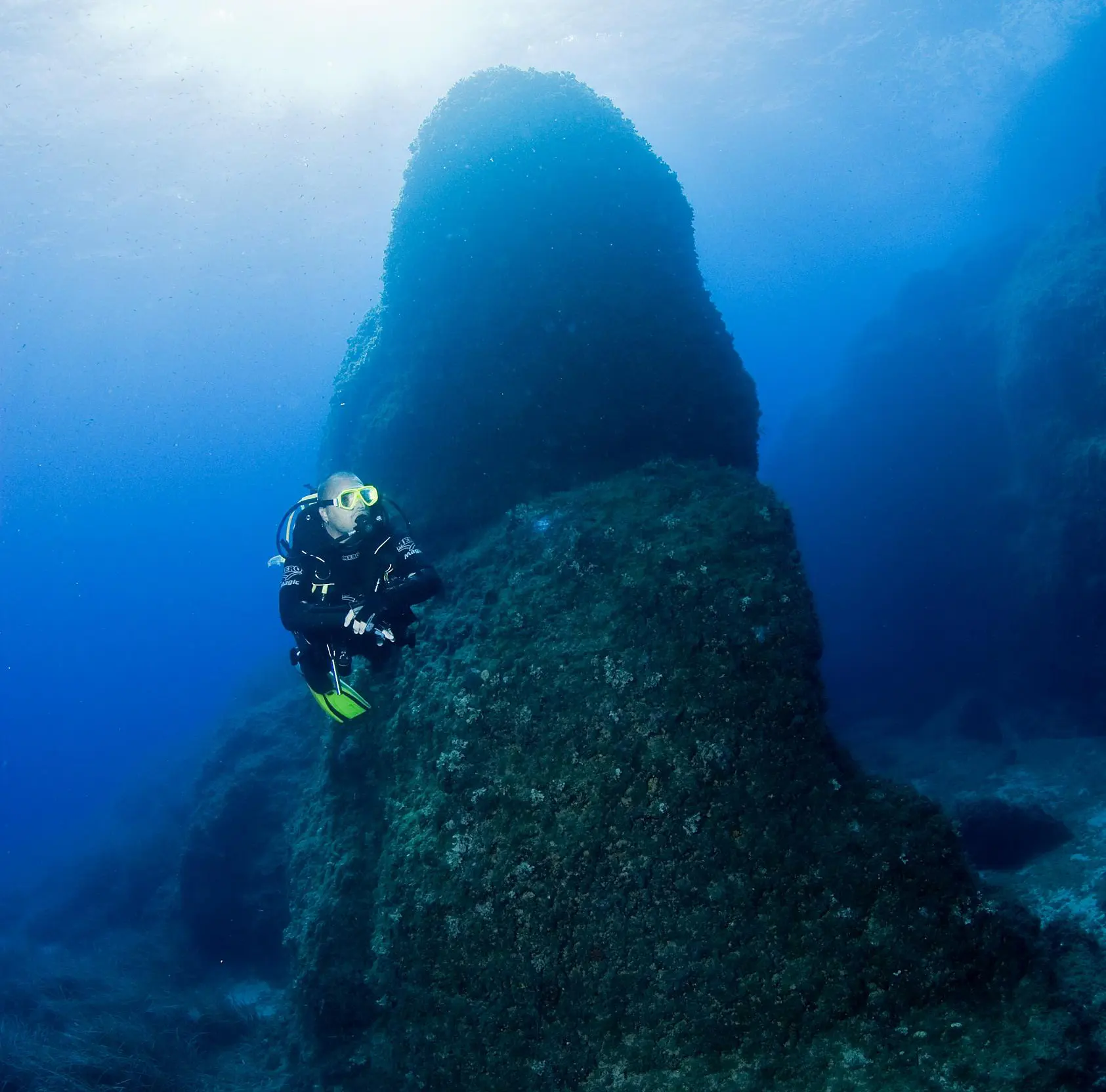
Submarine Rock *
At the end of a sheltered bay called Cala'n Forcat we come to a drop-off with a sandy bottom that takes us to 18 metres. To the right we can see Submarine Rock looming, and we follow the impressive canyon that it forms with the reef, while searcing for scorpion fish and octopus. Above the sea grass behind this canyon we often find a large group of barracudas as well as amberjacks and trigger fish. With luck it is also possible to see bonitos and sometimes even tuna of up to 2 metres! There is also an extensive amphora field here; the former cargo of a Roman vessel. Depth: 8 - 22 metres.
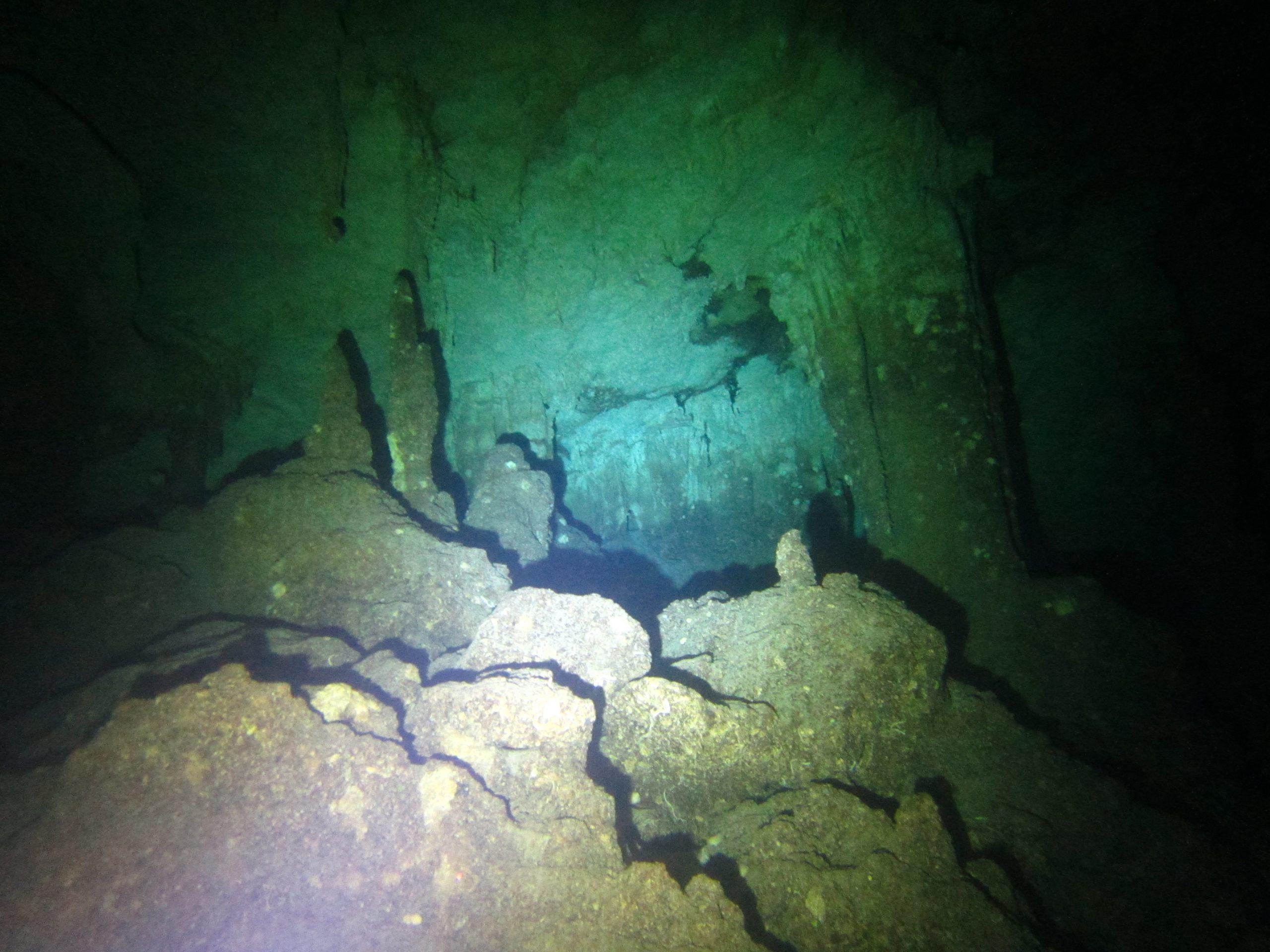
Organ Loft ***
We find the entrance to this cave at a depth of 13 metres. The entrance is quite large, but after about 20 metres the ground rises sharply to a circular chamber and from here we lose sight of the entrance. Looking over our left shoulder, we see a gallery of stalactites and stalagmites. The bottom in this part of the cave consists of a mix of very fine sand and particles, and one wrong move of our fins will reduce visibility to zero. We follow a 1.5-metre-high tunnel, which curves to the left while the ceiling drops to about 1 metre in height. Again, the tunnel turns to the left and on our right, we see crevices in the rocks favoured by conger eels. A little further on, a hole in the ground brings us back to directly in front of the cave entrance.
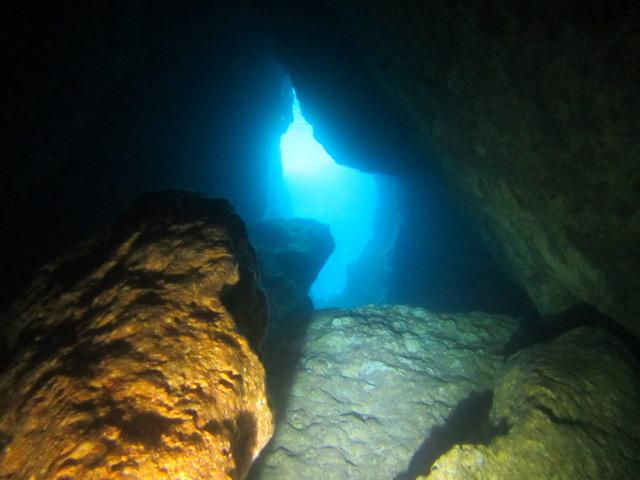
Tunnel Vision */**
Located in Cala'n Blanes, we enter this tunnel through a shallow opening in the rocky coast. Inside we find a tunnel half filled with water. Somewhere in the middle the tunnel splits in two and comes together again before opening out into a large opening at 12 metres depth. Inside we can find octopus, shrimps and crabs.
Outside the tunnel is a wonderful drop-off down to 25 metres where we often encounter parrot fish, nudibranchs, barracuda's and eagle rays. We have the choice to either return through the tunnel by the second passage-way or follow the impressive coastal wall back to our starting point.
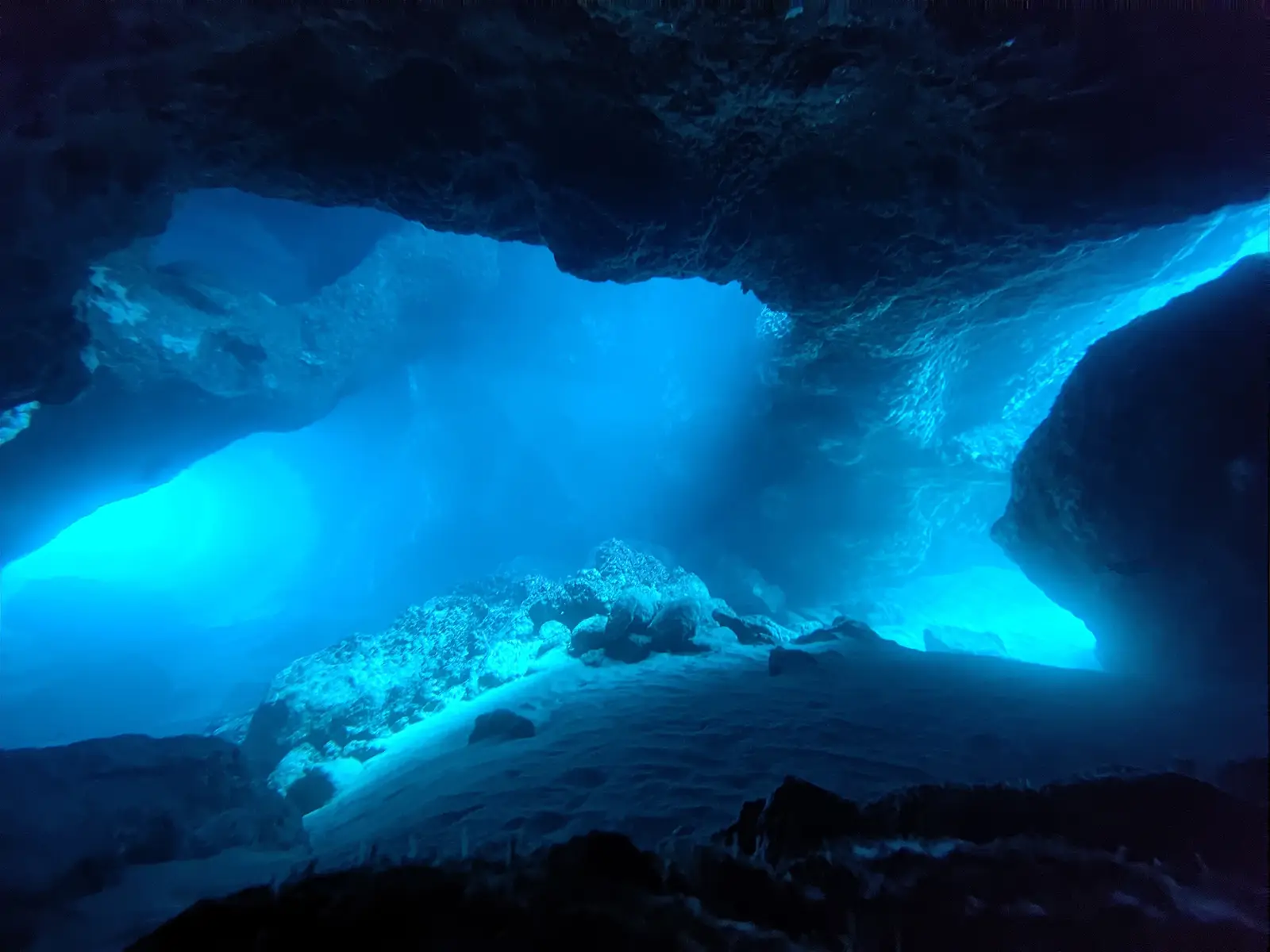
Swiss Cheese */**
Hollow rock on Menorca's north coast with tunnels, canyons and chimneys where we can swim in and out to our heart's content. Swiss Cheese is one of Menorca's most famous dive sites and a must-see.
A 50-metre long path leads us to a beautiful protected cove, where the dive site is located. On our way to the cavern we can see nudibranchs, moray eels and octopus. In Swiss Cheese, we find scorpion fish, small crabs and several conger eels. In the spring we can also see the odd slipper lobster.
North of the entrance, at a depth of 30 metres is a sandy bottom where we can see rare white gorgonians and small stingrays.
A dive site for all levels, as the dive plan can easily be adapted.

Santa Clara wreck ****
On 20 April 1983, the fishing vessel Santa Clara suffered an engine failure 45 nautical miles northeast of Menorca during a heavy storm. While a rescue operation was being organised, the crew of the Clara presumably dumped contraband tobacco overboard. She was later towed to the port of Mahon, where her crew simply disappeared. After spending several years at the naval base in Mahon, the Santa Clara was sunk by the Spanish navy in July 1988. She lay undisturbed for 9 years resting at a depth of 47 metres off Punta de Rafalet until she was rediscovered in 1997.
The wreck lies upright on a sandy bottom, forming an artificial reef. The wheelhouse is at 41 metres and the forward mast at 35 metres depth. We plan this dive on request and in cooperation with one of our partner dive centres.
